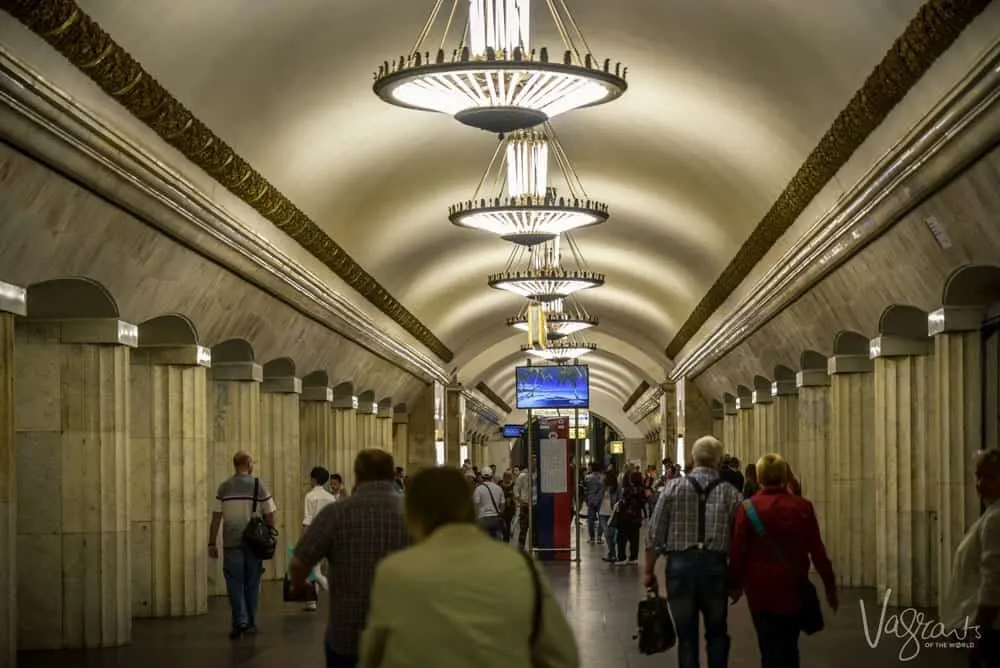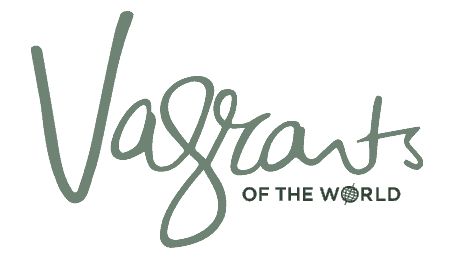Your first encounter with the beautiful Moscow Metro stations will surprise you. Never has a rail system been more appealing and just a little intriguing.
Once described as a ” Subterranean paradise for the people”, the Moscow Metro is one of the most extraordinary subway systems in the world
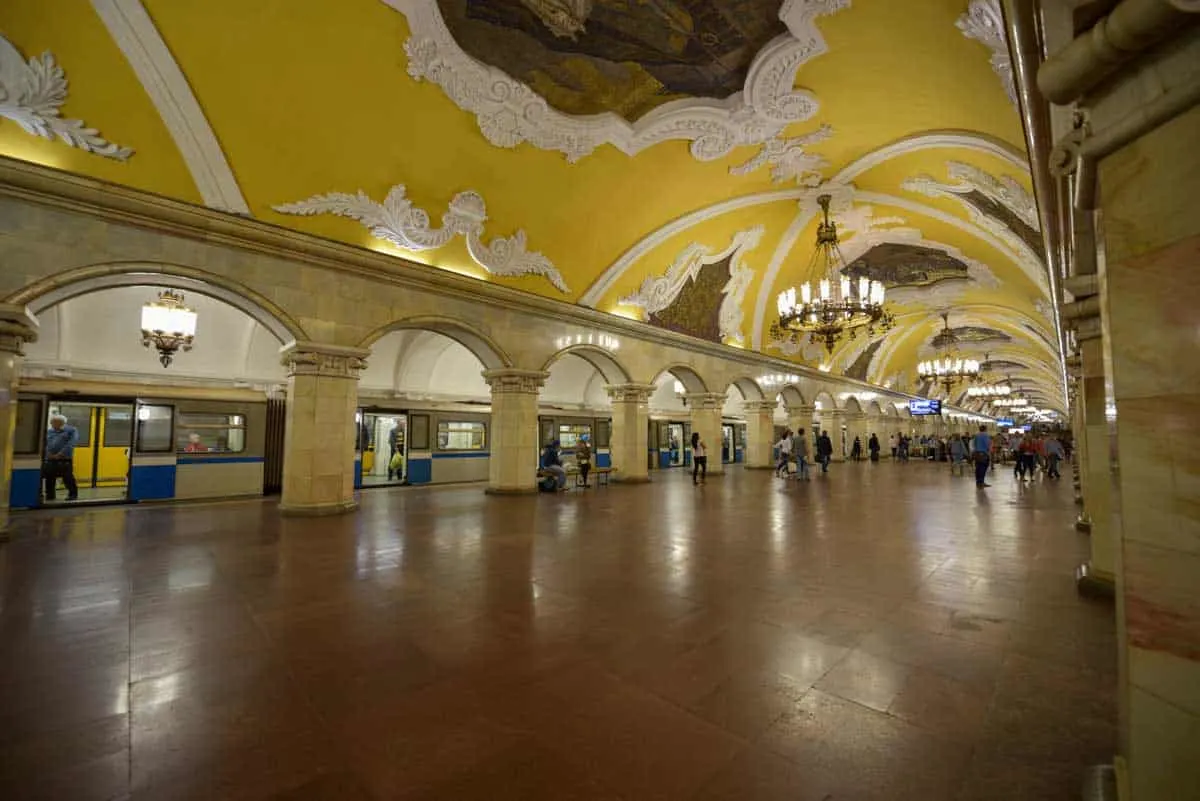
Most Beautiful Metro Stations in the World
We have travelled on a lot of public train systems all over the world. We have marvelled at the modern efficiency of some rail systems, especially in Asia.
We have baulked at the cost of others such as the Tube in the UK and in New York, we pondered which is uptown and which is downtown in relation to where we need to be.
We have also enjoyed a polite attitude to public transport and ease of navigation, in places like Athens.
We have discovered first class can be anything but classy and navigated our way through some of the dirtiest and some of the cleanest train systems the world has to offer. However, we have never come across anything as impressive as the Moscow Metro stations.
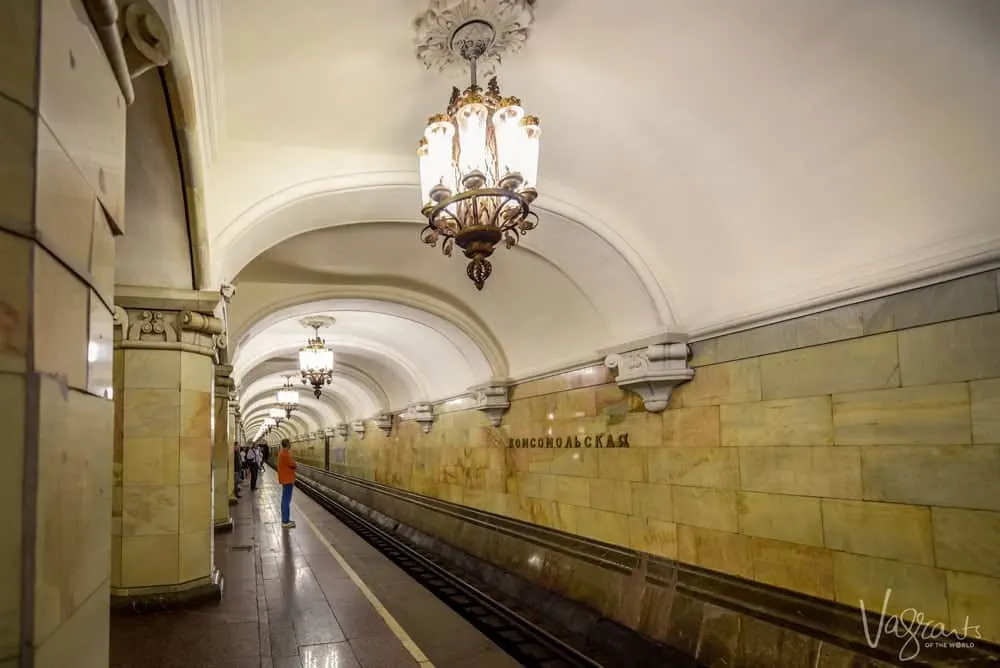
How Many Metro Stations are in Moscow?
The first Moscow Metro system opened in 1935 with 13 stations along a single 11-kilometre (6.8 mi) line.
As of 2021, the Moscow Metro has grown to include 241 stations (276 including the Moscow Central Circle Line) The entire Moscow Metro length is 412.1 km (256.1 mi), making it the fifth-longest metro system in the world. China has the four longest.
Nearly 10 million people commute on the Moscow Metro each day making it one of the most heavily used systems in the world and the busiest metro system in Europe. It is no wonder it is considered a tourist attraction in itself and one of the best things to do in Moscow.
How Deep is the Moscow Subway?
The majority of the Moscow Metro system is underground with 70 deep-level stations, nearly 90 shallow stations and the remainders either on the surface or at elevation.
The deepest station is Park Pobedy Station which is 84 meters, (275 ft). At roughly the same height as a 28 storey building, it is one of the deepest metro stations in the world, behind St Petersburg’s Admiralteyskaya Station which is located 86 meters (282 ft) below ground.
Get a Moscow Metro Map
There are several multicoloured maps of the metro system in each car and there will be an announcement each time you arrive at a station. These announcements should be in Russian and English but may not always be easy to understand, so it will be handy to have a map, or app in English to help you navigate your way.
Moscow Metro Map:
You can download a map of the Moscow Metro in English here. However, using a Moscow Metro App might be more informative.
Moscow Metro App:
Download the official Moscow Metro app which gives you up to the minute information. Or, download apps you can use even when offline. Download the Moscow Metro App for IOS Here. and for Android Here.
Why Are the Moscow Metro Stations So Beautiful?
Stalin’s Vision For the Moscow Metro
Stalin had the vision to create a magnificent Metro system that would resemble “People’s Palaces”. His vision was realised in 1935 when the Metro was opened with just 13 stations.
Moscow Metro Art and Design
Every station has a unique design indicative of the era and political leader of the time. Stories of Russia’s history that make you want to keep exploring these “subterranean palaces“.
Lined with marble and decorated with chandeliers, intricate mosaic artworks, heroic statues and gilded trimmings, the Moscow Metro stations are not merely decorated; they are works of art.
An entire day can be spent station hopping, admiring beauty and opulence that would have received a nod of approval from the Romanov’s themselves. We share a small sample of the best Moscow Metro stations and what you will expect to find in this underground art gallery.
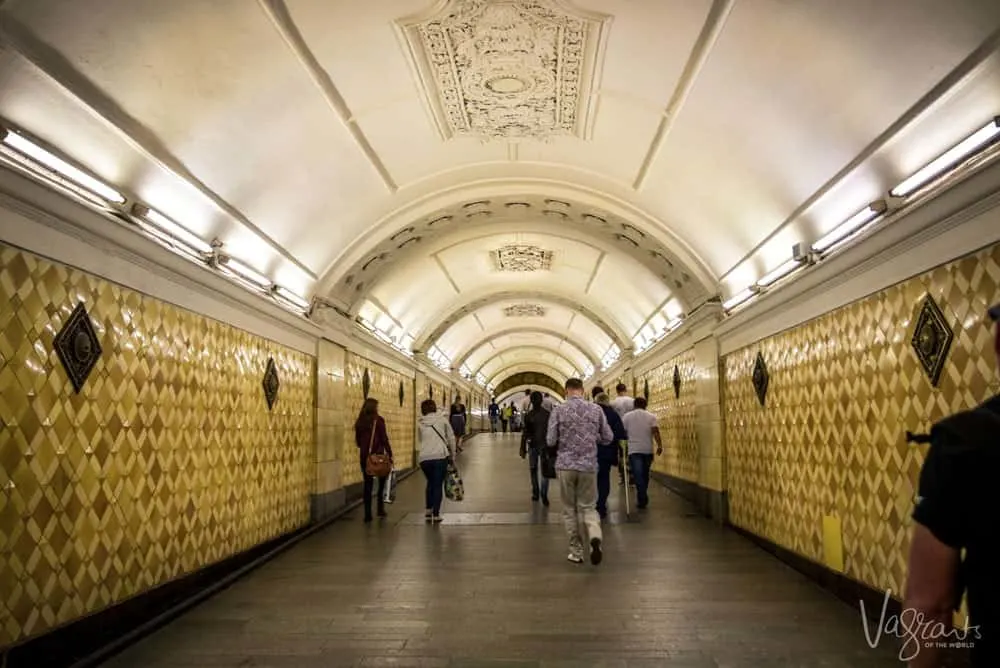
Moscow Metro History
The first underground system in the Soviet Union, the initial metro stations were built by forced soviet labour. Much of the design and artworks within the stations depict the Soviet Union’s greatest achievements and historical milestones as well as paying homage to Russia’s diverse artistic, literary and architectural legacy.
British engineers were commissioned for the initial project because of their experience with the London underground system. Interestingly, they were later arrested on suspicion of espionage. It was believed they knew too much about the Russian underground system.
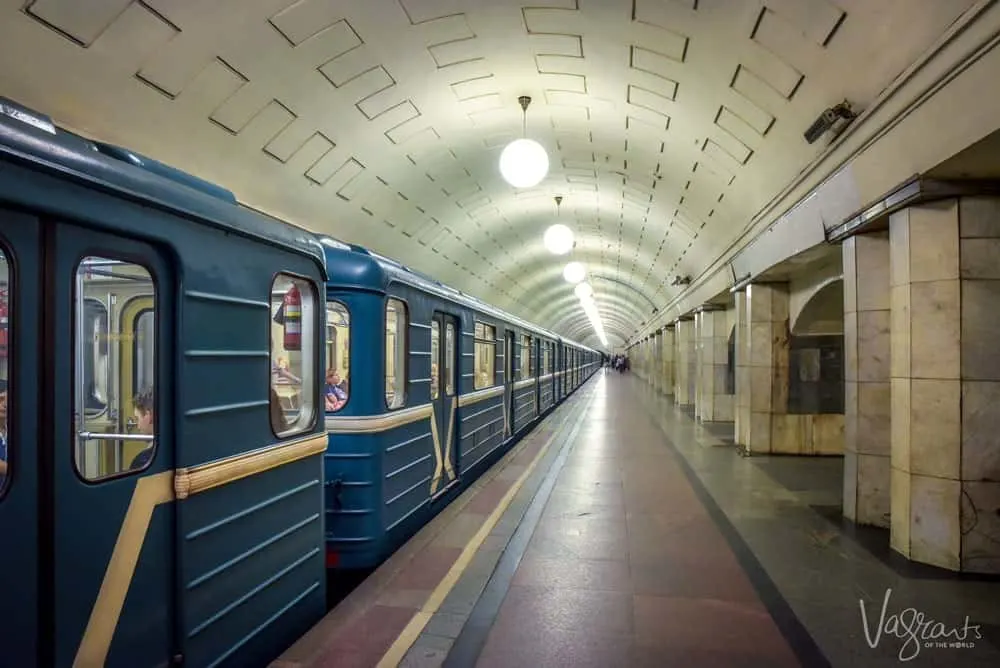
How to Use the Moscow Metro System
Not only is the Moscow Metro beautiful, extremely clean and very safe, it is also a cheap way to get around Moscow. Although, travelling on the Moscow Metro can be a little daunting.
It is the second busiest rail system in the world so it can get very crowded. Here are some tips to help you navigate the Moscow Metro.
Navigating the Moscow Metro. Travelling from Station to Station
Travelling between stations on the Moscow Metro can be challenging, especially when it is busy. In addition to using a Moscow Metro app or map, these tips for using the metro will help if you are unsure about stations or lines.
Listen to the Voice on the Annnouncement
- Usually, the announcement of the next station will be by a man’s voice on the trains travelling to the city centre.
- On services travelling away from the city centre, announcements will be a woman’s voice.
- On the circular line – the maroon coloured line, a man’s voice announces the stops if it is travelling in a clockwise direction and a woman’s voice if it’s travelling counterclockwise.
Signage in the Metro
There is a comprehensive signage system throughout the metro system showing the various lines, colour coordinated to correspond with each line.
- You will see overhead signs showing which way to go to access each line.
- Detailed maps on the platforms show the direction of the train, which stations it will stop at and the station you are currently at.
- Large colour coded stickers on the floors show where you need to change lines.
All signs are written in Russian Cyrillic and English. If you get overwhelmed, look for the colour line on your map and the final station on that line and follow the signs.
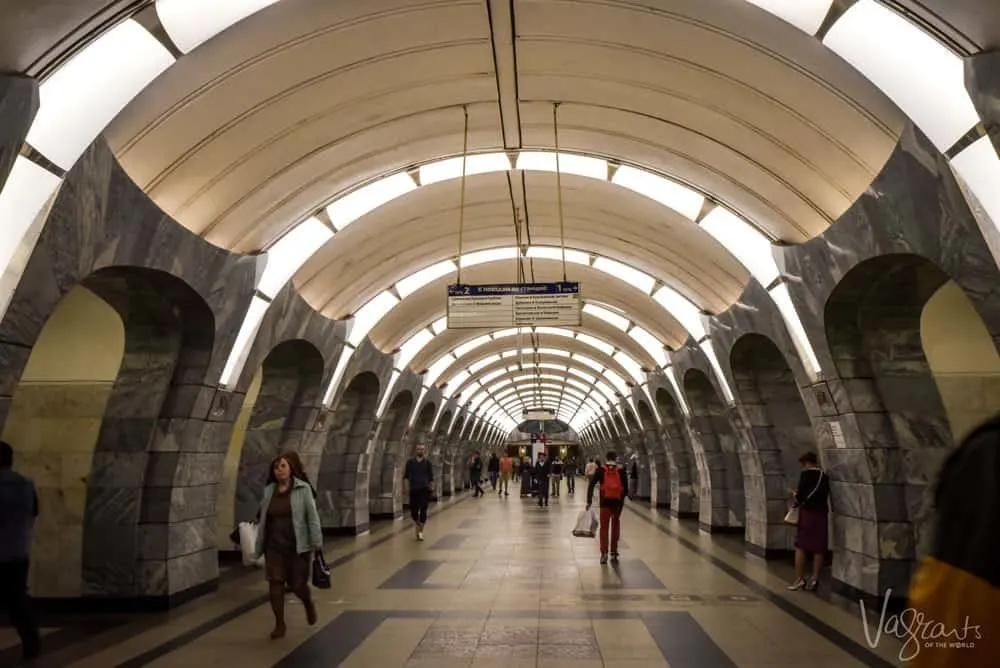
Exiting the Metro
Most of the metro stations will have several exits. Busy stations in the city centre, such as Kitai Gorod can have as many as 15 exits. For visitors to Moscow, this can be quite daunting.
Exits are all numbered. Look for maps at the exits or signs in lobby areas showing the surrounding area and major sights which can help guide you to the right exit number.
You will also see overhead signs at exits listing the nearby sights, streets, shopping malls, and other reference points to help you navigate.
Around the station walls, you will also see signs guiding you to public transport stops with bus, tram and trolleybus numbers.
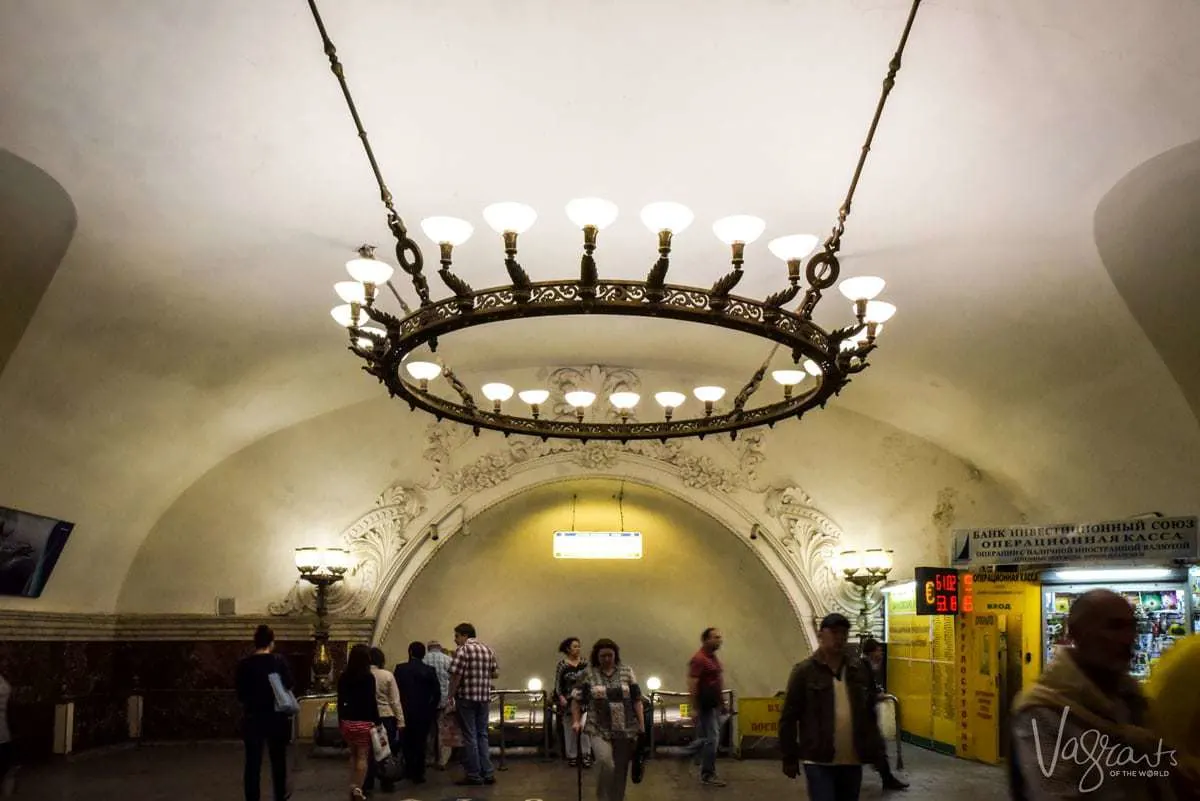
Escalators
With some of the deepest stations in the world, you can expect some very long and steep escalators. The longest escalator in the Moscow Metro is 413 ft (126 metres). Climbing such a long-distance means the escalators also move faster than many people are used to.
Along with the steep angle of the ascent and descent, boarding the fast-moving escalators can be a bit nerve-racking at first. Approach with confidence and don’t hesitate when boarding. Remember to stand on the right of the escalator to allow people to pass.
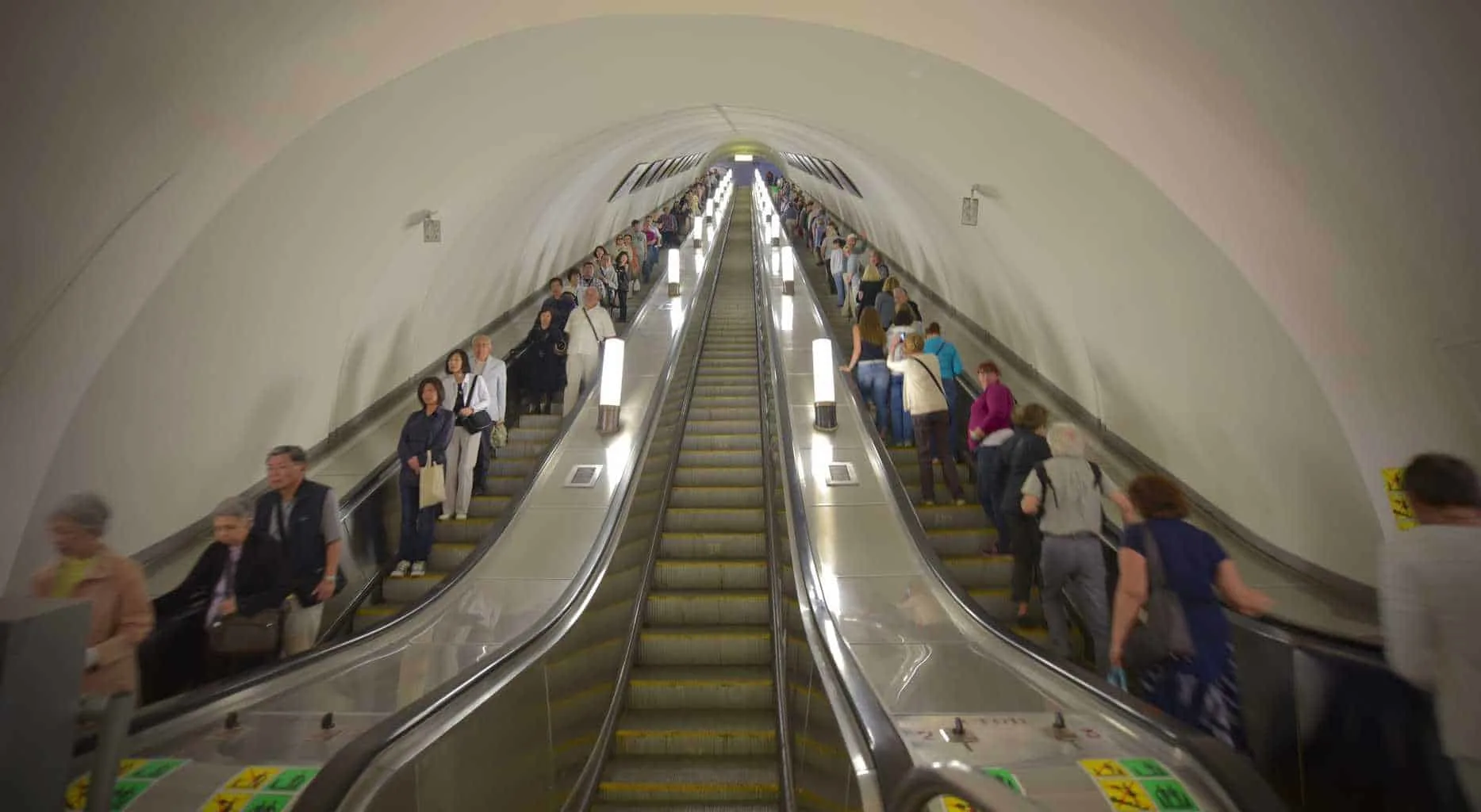
Avoid Rush Hour
As mentioned, the Metro moves more than nine million people each day around Moscow. If you are planning to spend some time exploring the Metro system, it would be wise to avoid rush hours.
Rush hours on the Moscow Metro are between 8.00 AM and 10.00 AM and again between 5.00 PM and 7.00 PM
During rush hour, the train cars get very crowded and you will have to move fast to get on and off the trains as well as trying to avoid being pushed around too much. It will also be more difficult to read the station names from inside the train cars. This will make trying to navigate the system more difficult and will not be as pleasant an experience.
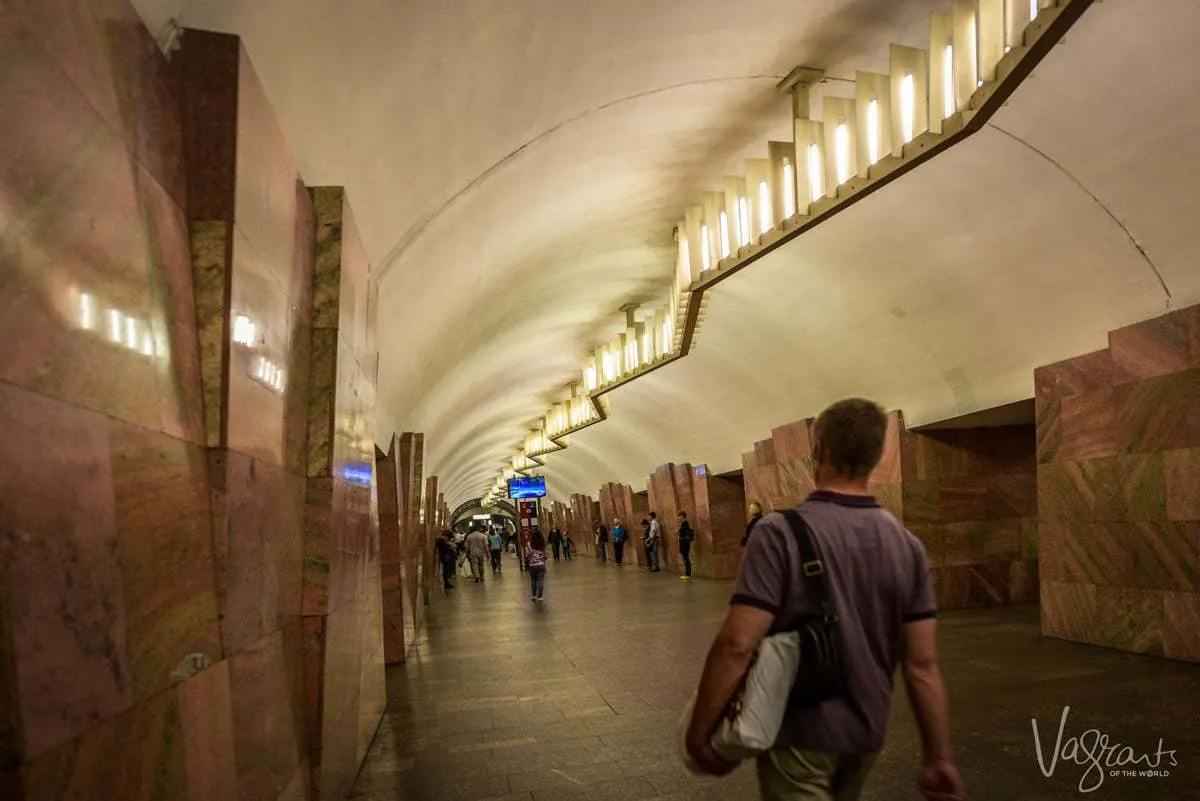
Safety on the Moscow Metro Watch Your Belongings
The Moscow Metro is well monitored with security staff and cameras so is overall very safe. However, like any busy city, the Moscow Metro attracts large numbers of people including pickpockets. Be extra careful at the most visited tourist stations, especially, on the Circle Line in the city centre.
The fascinating ballroom-like stations on the Circle Line not only attract tourists but is also connected to the 7 out of 9 Moscow railway stations so it always feels busy there. Make sure your bags are secure and zipped up at all times and valuables are secure in inside pockets. We highly recommend a good anti-theft backpack or anti-theft handbag for travelling in cities like Moscow.
Stay Safe in Moscow: Read Our Best Safe Travel Tips & Anti Theft Travel Gear Guides for a stress-free travel experience in Moscow.
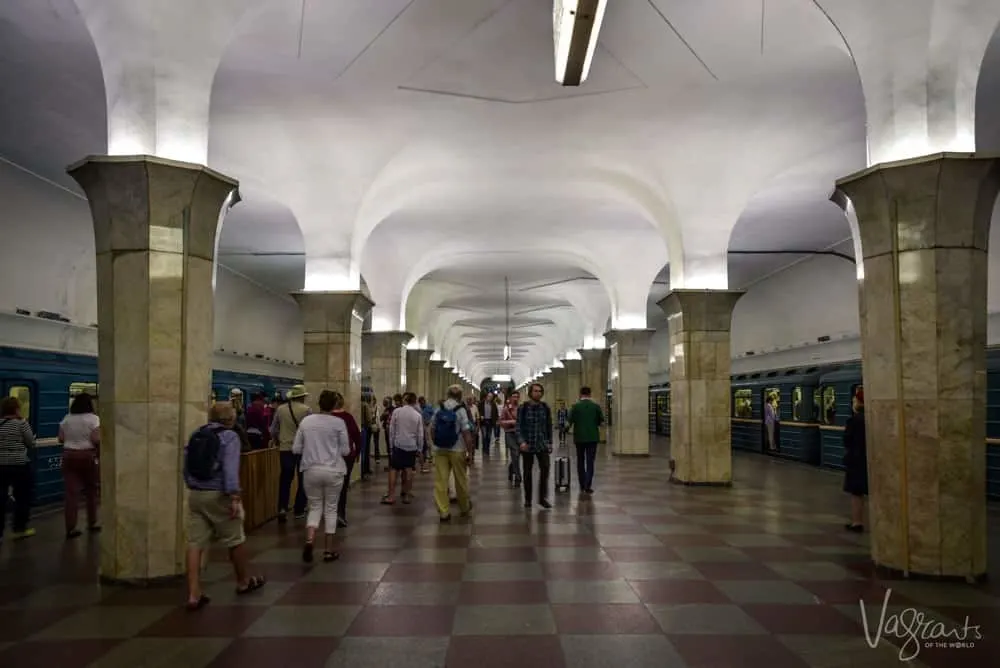
Moscow Metro Tickets
Ticket Cost
- A one way ticket or one trip ticket on the metro is ₽55.00 (less than USD $1) regardless of the length of the trip. Two trips ₽110.00.
- There are no zones so it doesn’t matter how far you travel or how long your trip is. You’ll need a ticket only once at the entrance to the metro. You may change lines as many times within the system on the one fare.
- A day or multiple day passes are also available. You can visit the Moscow Metro website here for full schedule of fares and payment options.
Purchasing Tickets
You can purchase metro tickets in two basic ways:
- Automatic machines – They are in both Russian and English so are relatively easy to use.
- Ticket booth – If you are not comfortable using the machines look for the ticket booths marked “KACCA”. There are both Russian and English speaking booths – look for ticket booths with a “we speak English” sign. However, if you can’t find an English speaking booth, you don’t need to speak Russian. Just hold up the number of fingers of tickets you need. Once you pay, you will receive a card that will serve as your ticket.
- Card payments are commonplace with contactless payment also possible. However, it is still wise to have cash with you in small denominations to purchase tickets incase cards are not be accepted or you need to use a mchine.
Guided Metro Tours in the Moscow Metro
If navigating the Moscow Metro on your own sounds too daunting, get yourself a Moscow Metro guide who will guide you through the metro system. They will take you to the most beautiful stations while revealing the history and stories that make this one of the most unique underground rail systems in the world.
Guided Metro tours are available for as little as USD $20.00 pp. A guided tour is also a great way to learn how to navigate the metro system so you feel comfortable exploring further on your own.
Recommended Moscow Metro Tours
Small-Group Moscow Metro Tour: See the nine most beautiful underground metro stations in Moscow on a 90-minute small group tour. Includes English speaking guide and metro ticket. See here for full tour details.
Moscow Metro & Bunker-42 Guided Tour: Tour the best Moscow metro stations and Bunker-42. The once-secret military complex, bunker, and communication centre is now a museum devoted to the Cold War between the USSR and the USA. The 2-3 hour tour includes all tickets and guides. See here for full tour details.

15 of the Best Moscow Metro Stations to visit.
A Metro Station for all Tastes
If it is the baroque opulence of the Stalin years that tickles your fancy or the beautiful sleek designs of modern stations you seek. The Moscow Metro stations have an array of designs that will take you on a journey through Russia’s history and quite simply impress you. These are some of the best stations to visit on the Moscow Metro.
Mayakovskaya Station Line 2 Green
Mayakovskaya Station is on the Zamoskvoretskaya line – Line 2. Used as a bomb shelter during the war, a hospital and even a supreme command headquarters. In 1941, Stalin celebrated the anniversary of the Bolshevik revolution at Mayakovskaya Station, complete with elegant catering for all the attending dignitaries while the Nazis bombed the city above.
The scene was later depicted in the mosaics in the centre of each dome. Historic moments like this captured in various stations shows how fascinating the Moscow Metro is.
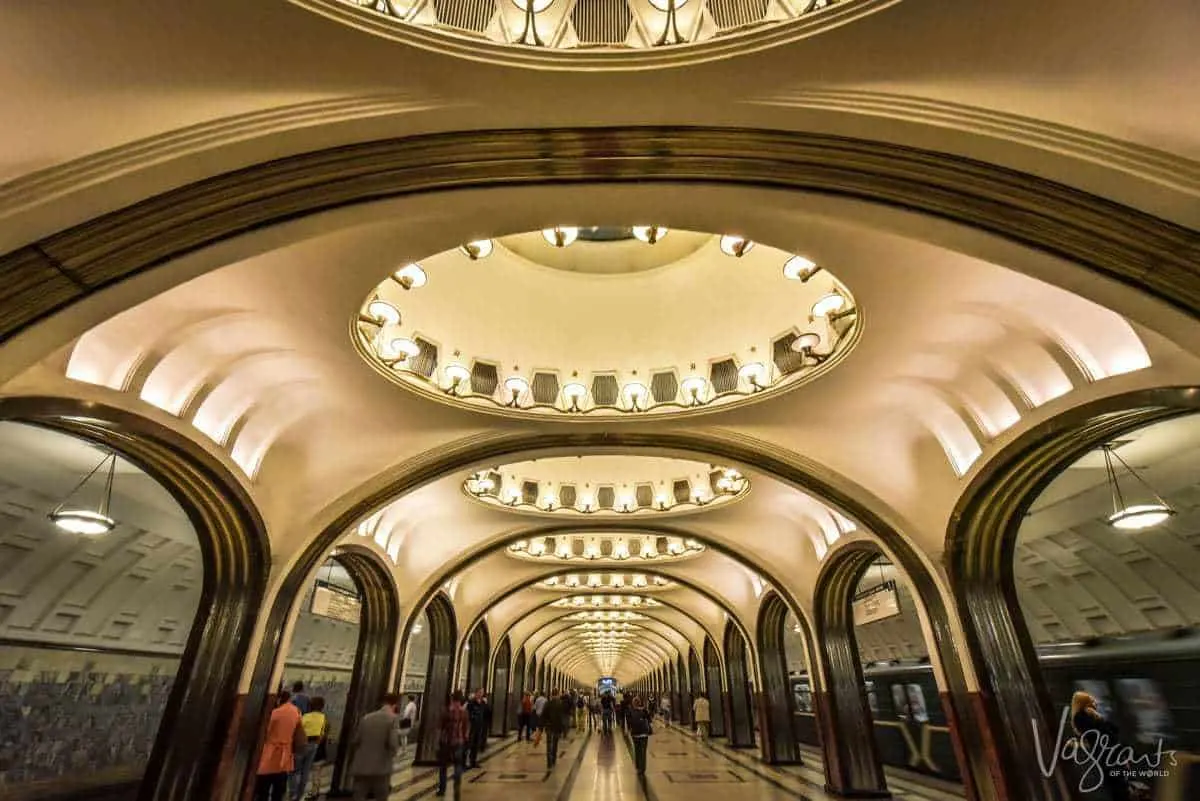
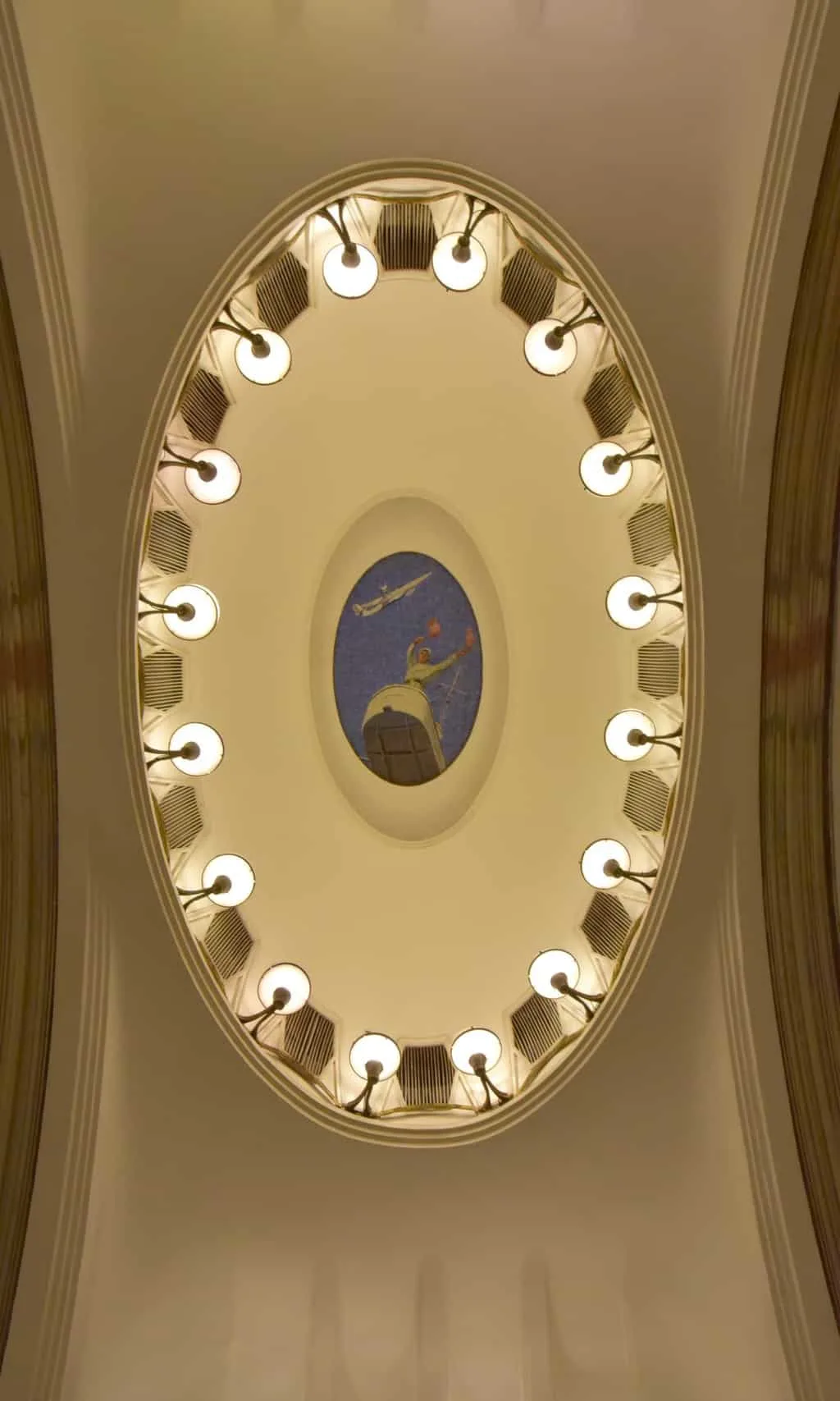
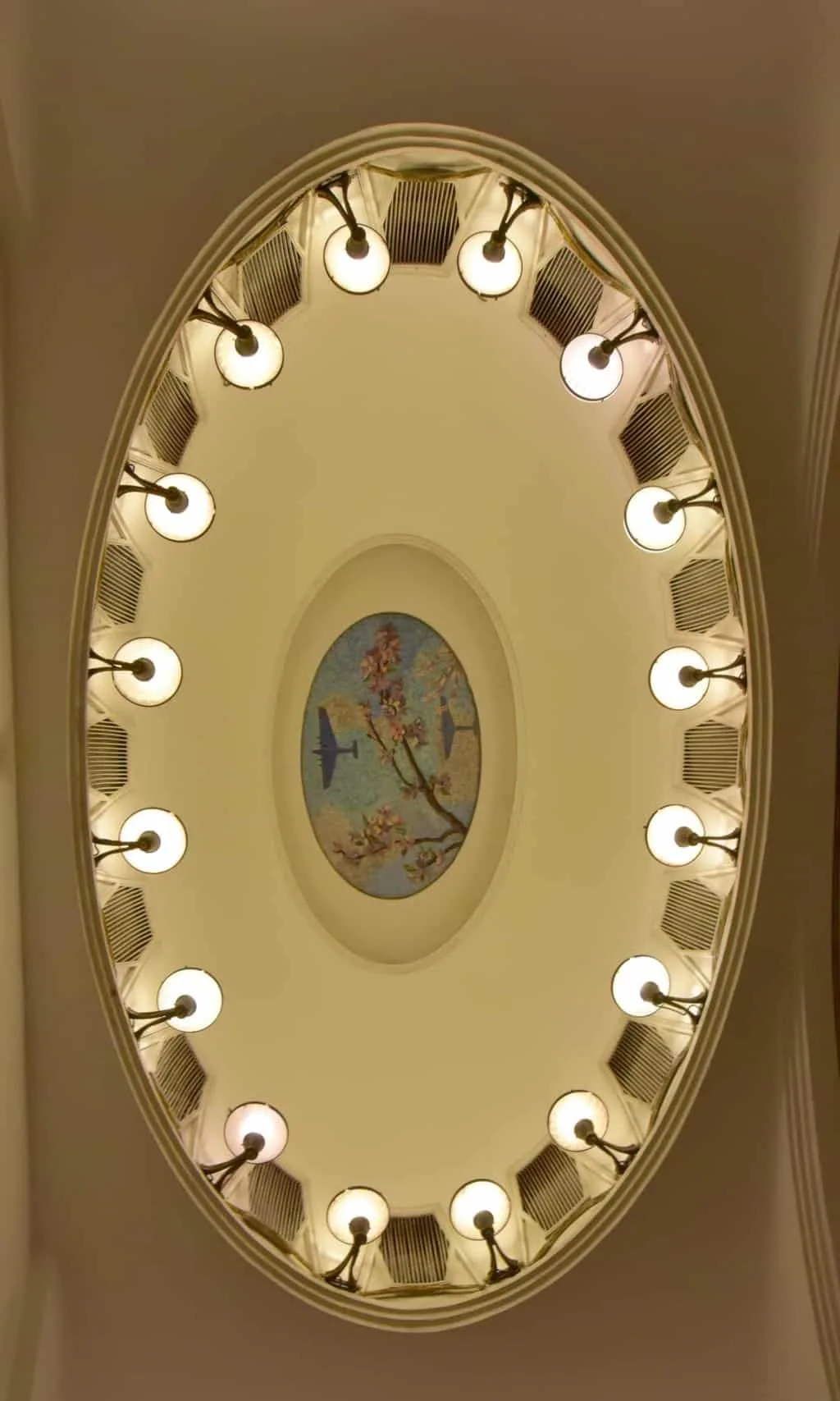
Teatralnaya Station Line 2 Green
Teatralnaya Station is on the Zamoskvoretskaya line – Line 2. Named for the nearby Theatre Square, Teatralnaya Station opened in 1938 as part of the second stage of the Moscow Metro construction.
Designed as a tribute to the arts, this pretty station is lined with fluted pylons and white marble salvaged from the demolished Cathedral of Christ the Saviour.
Novokuznetskaya Station Line 2 Green
Novokuznetskaya Station is on the Zamoskvoretskaya Line – Line 2. In honour of Soviet fighting men, seven octagonal ceiling mosaics, bas-reliefs and cast bronze portraits depict soldiers of the Red Army and Russian war heroes.
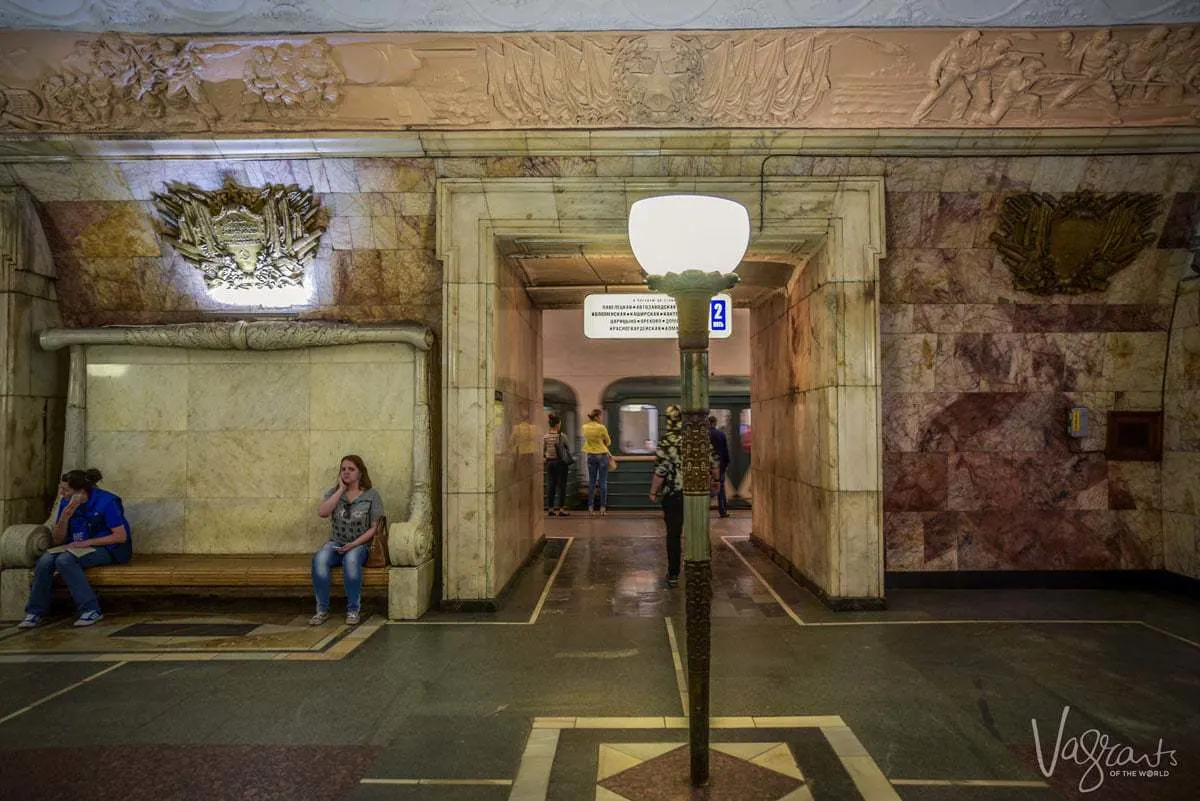
The large, ornate marble benches that line the platform marble walls were taken from the cathedral of Christ the Saviour and original floor lamps give Novokuznetskaya Station a special ambience.
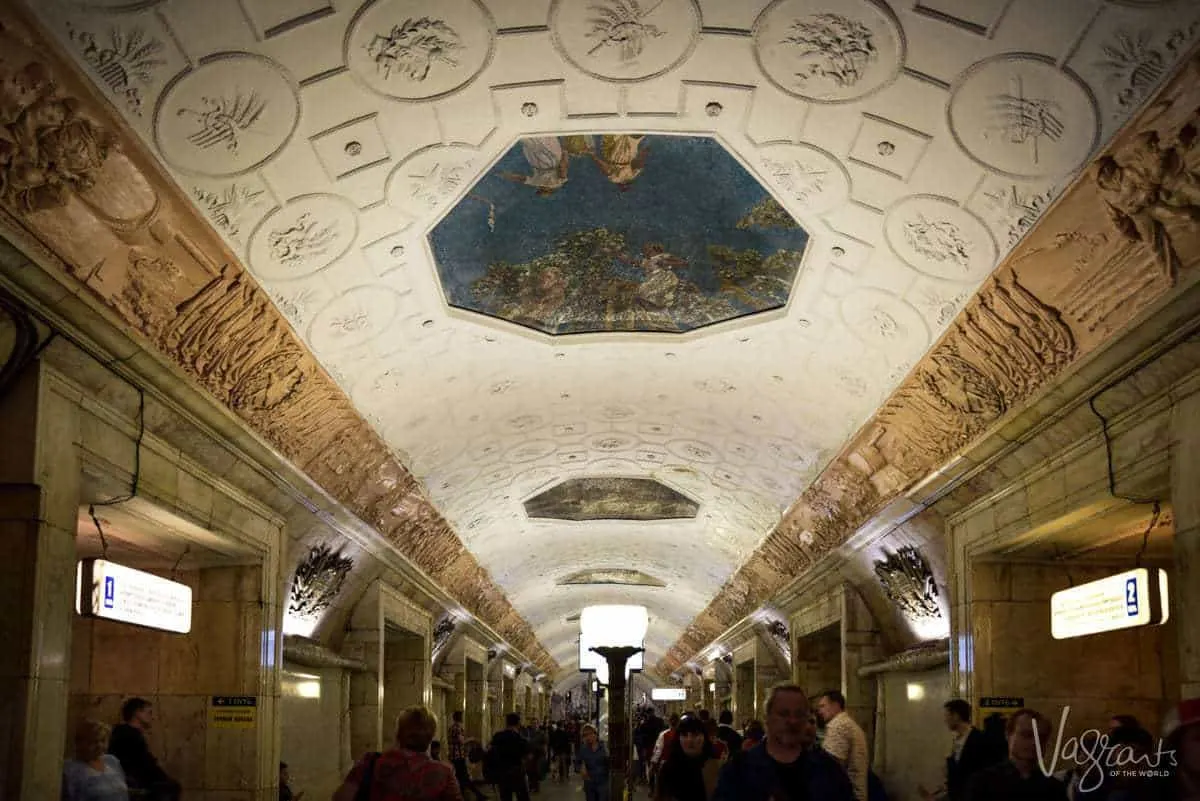
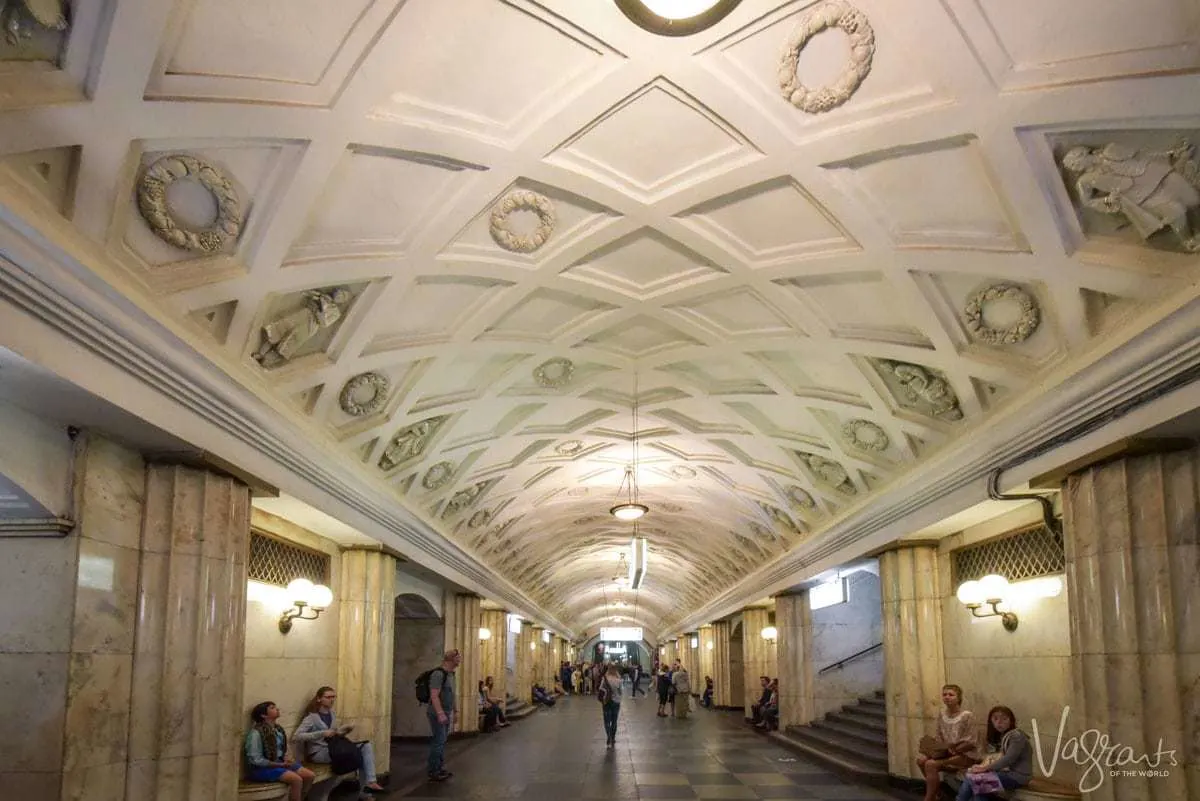
The central hall is decorated with crystal lamps and bas-reliefs depicting the theatre arts of the USSR made by the Leningrad Porcelain Factory.
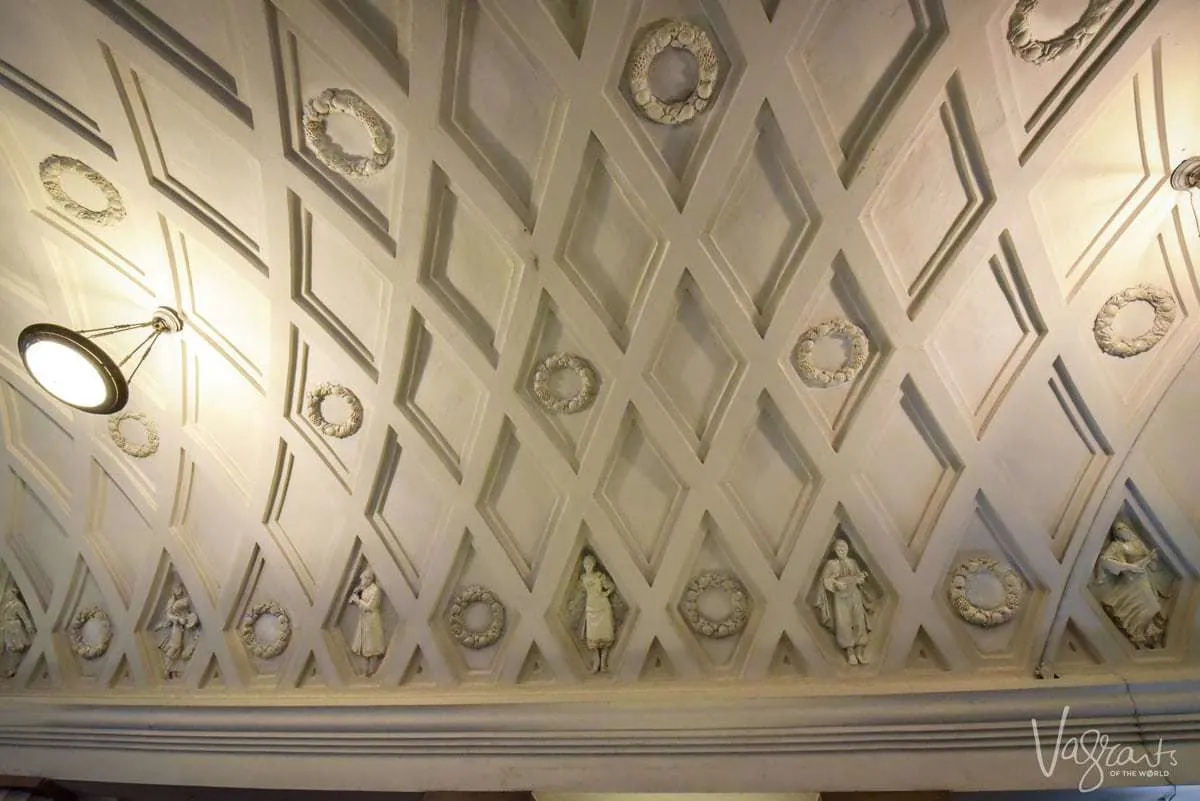
Ploshchad Revolyutsii Station (Revolution Square) Line 3 Blue
Ploshchad Revolyutsii Station is on the Arbatsko–Pokrovskaya line – Line 3. Revolution Square is one of the most famous stations and one of the closest stations to Red Square.
Easily one of the most impressive, it is lined with life-size bronze sculptures depicting the people of the Soviet Union; workers, peasants, soldiers, artists and children – 72 in total.
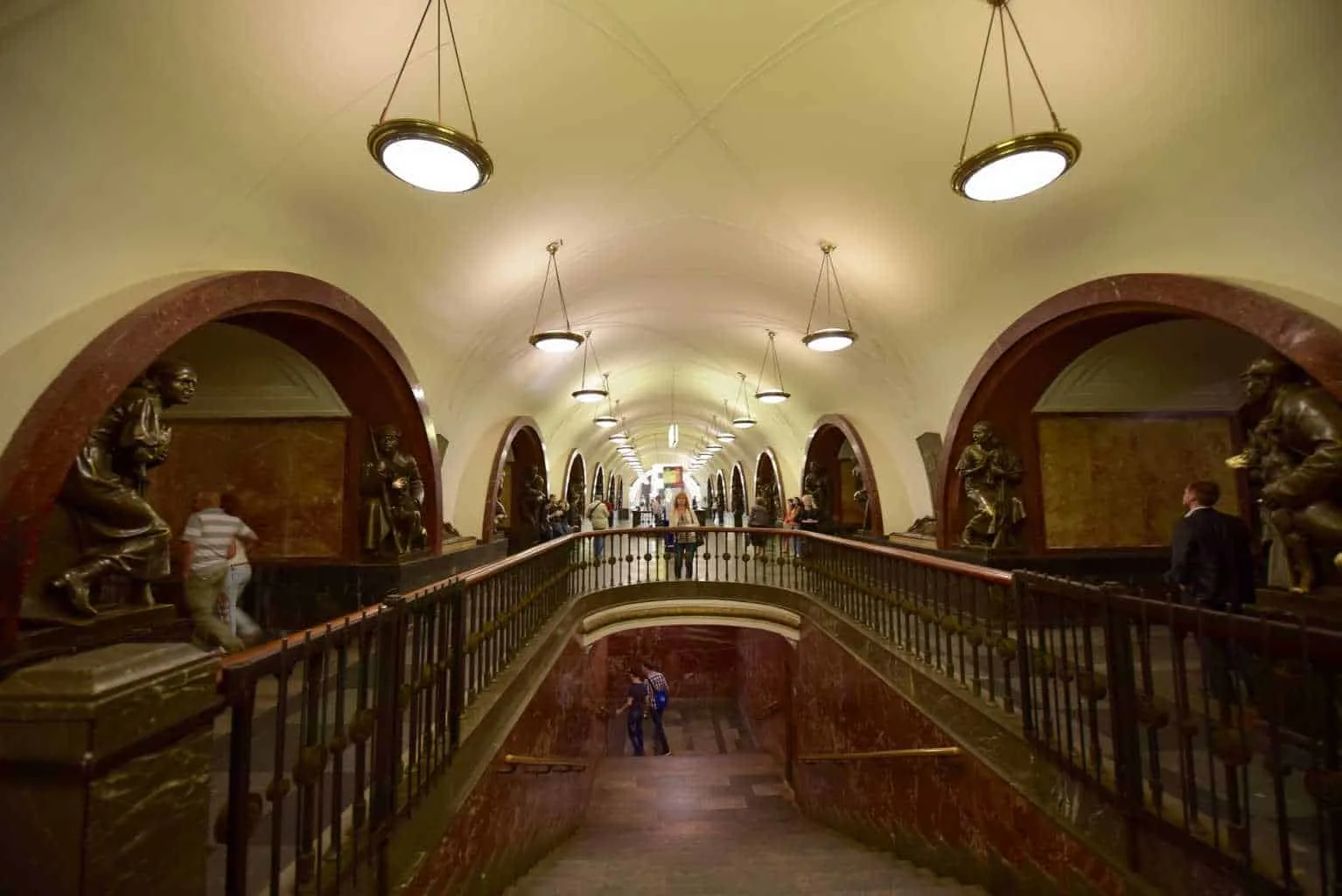
Tradition states it is good luck to rub the nose of the dog depicted in one sculpture and as if by reflex, we barely noticed anyone who failed to do so as they passed.
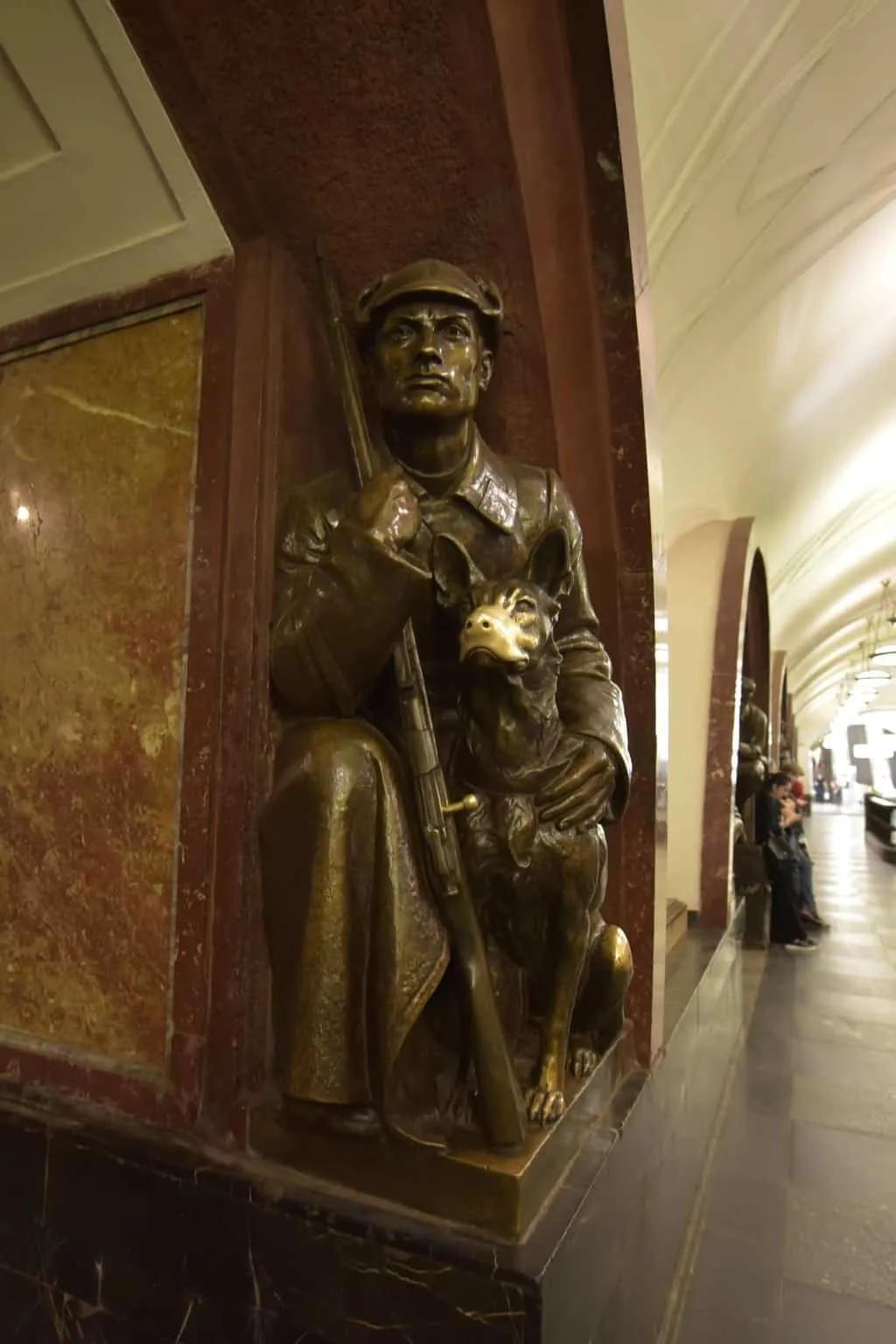
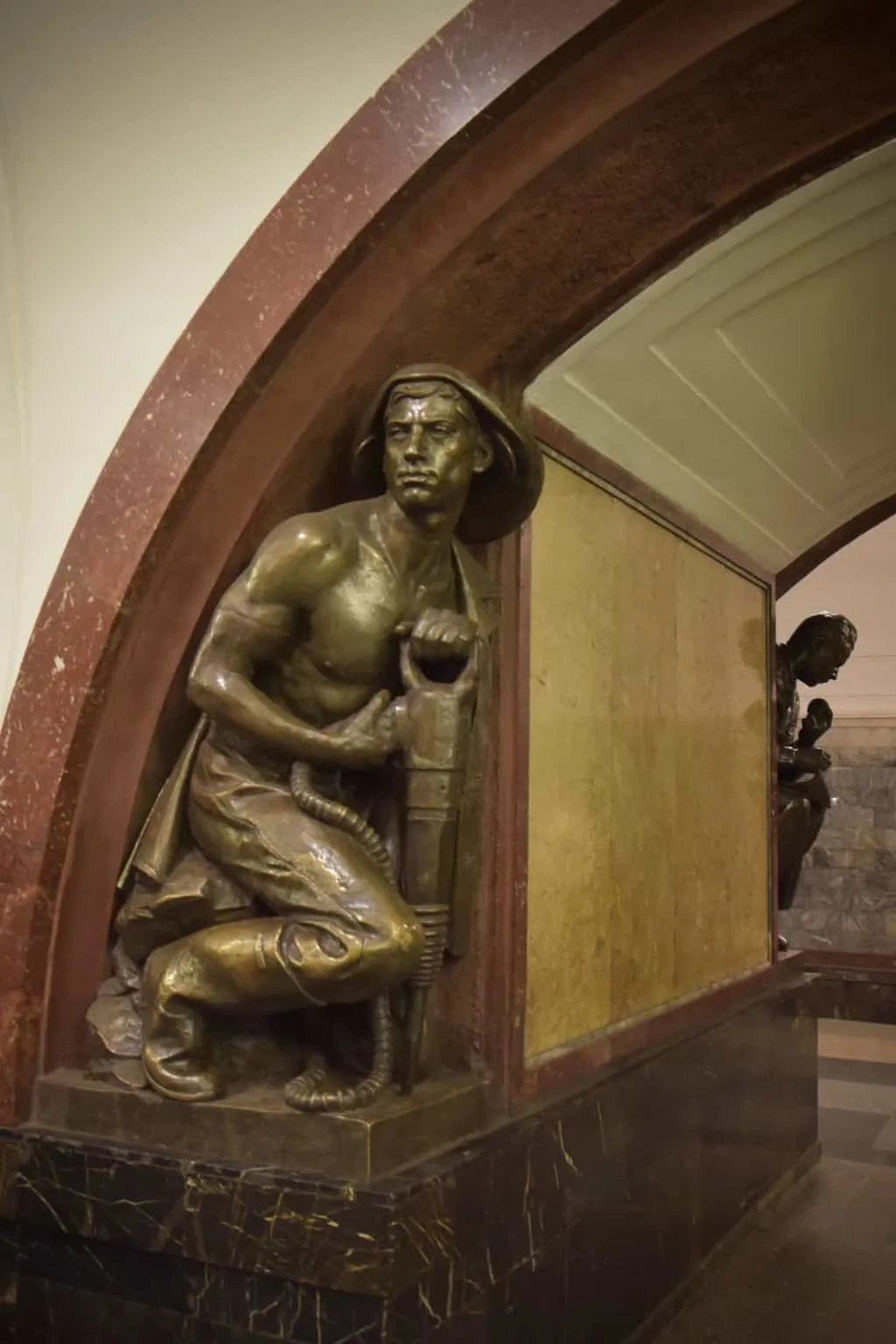
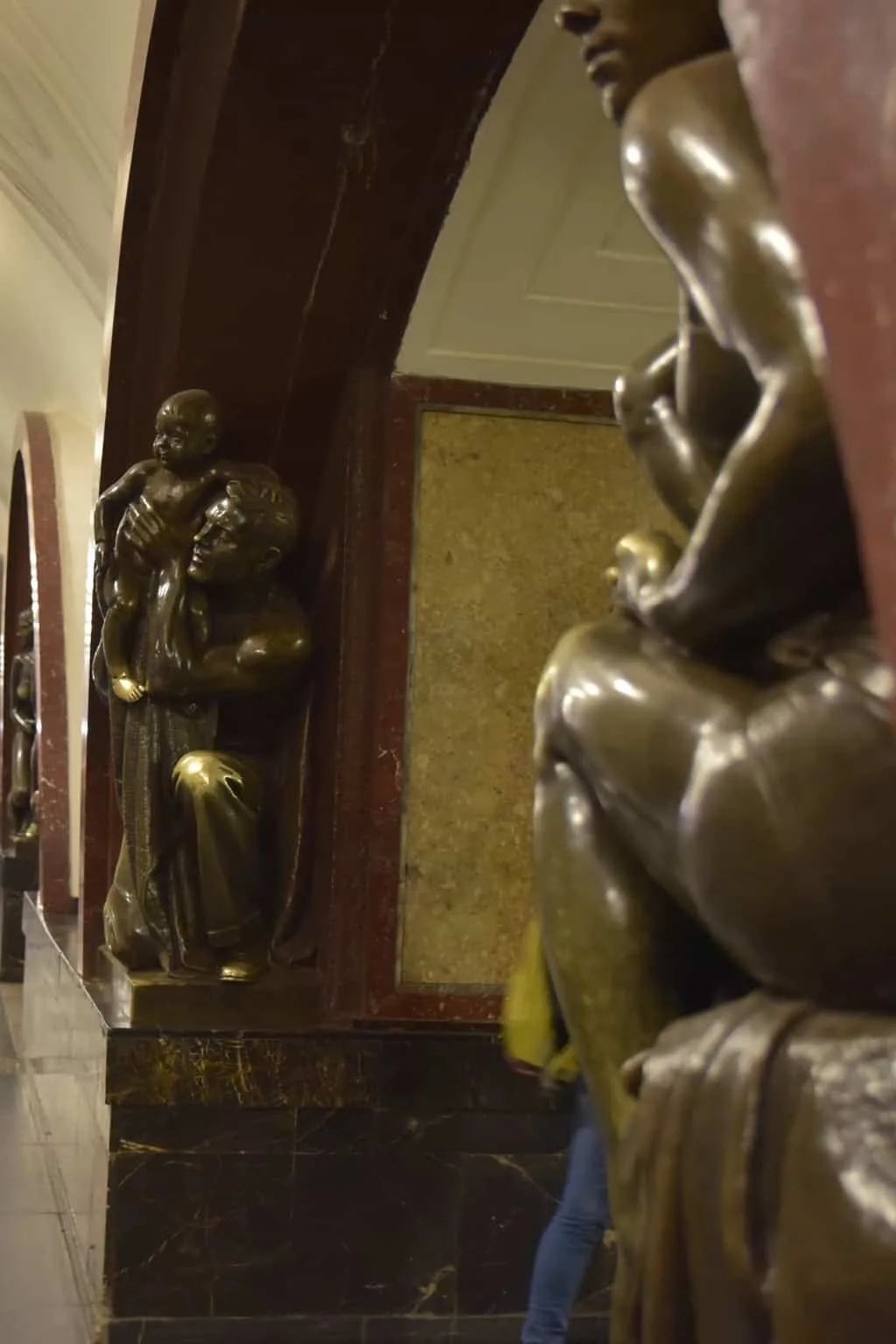
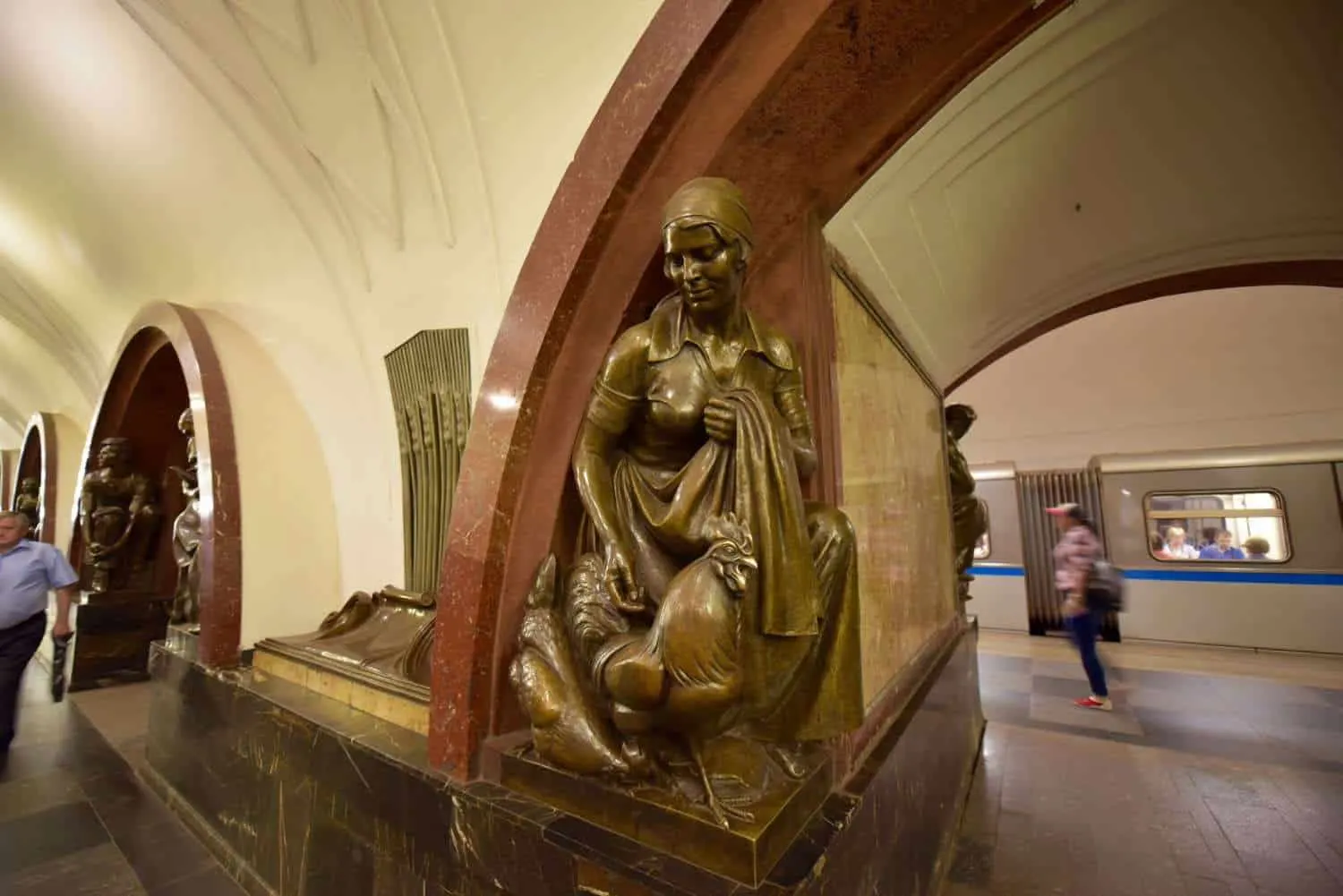
Elektrozavodskaya Metro Station Line 3 Blue
Elektrozavodskaya Metro Station is on the Arbatsko–Pokrovskaya line – Line 3. A favourite, this station was named after the nearby electric light bulb factory. The concept was to make a ceiling covered with six rows of circular incandescent lamps- 318 in total. Built during the third stage of the Metro construction, Elektrozavodskaya Metro Station opened during WW II in 1944.
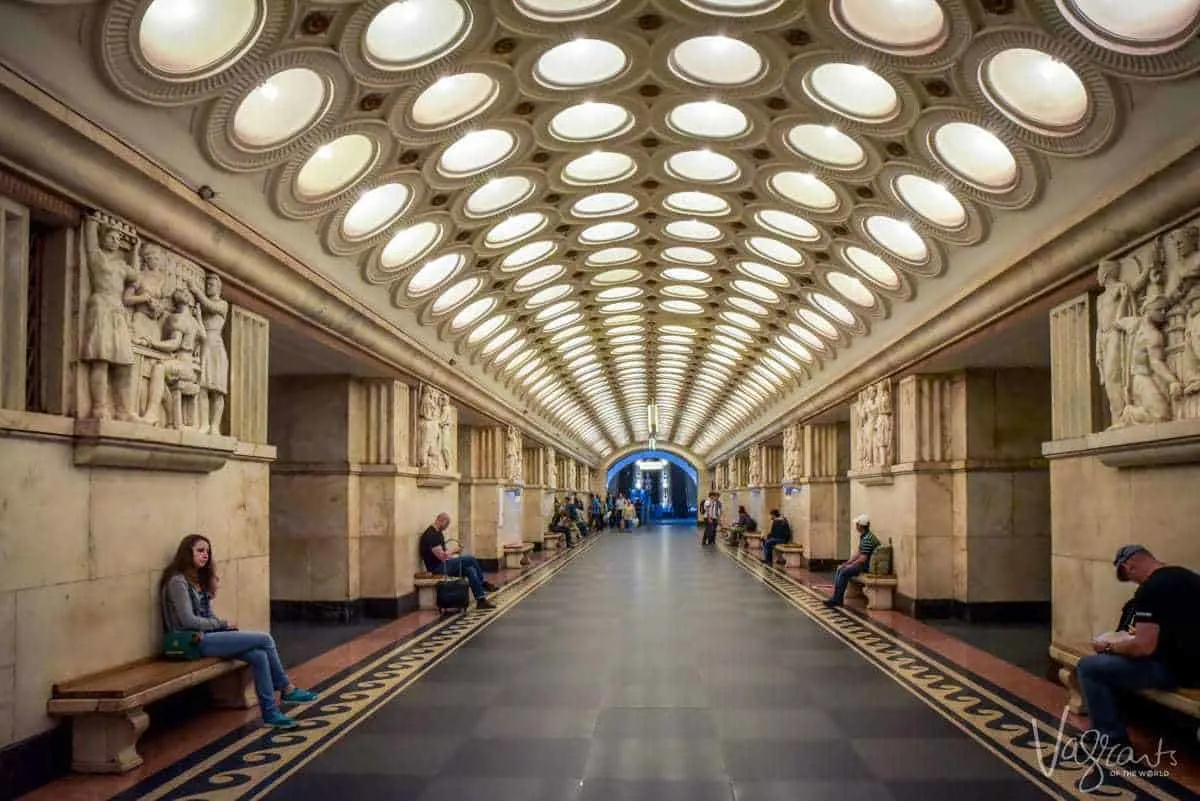
The station’s initial architect died during construction and the outbreak of the war halted works until 1943. Another architect finished the works incorporating an additional theme, bas-reliefs installed on the walls to document the struggle of the war.
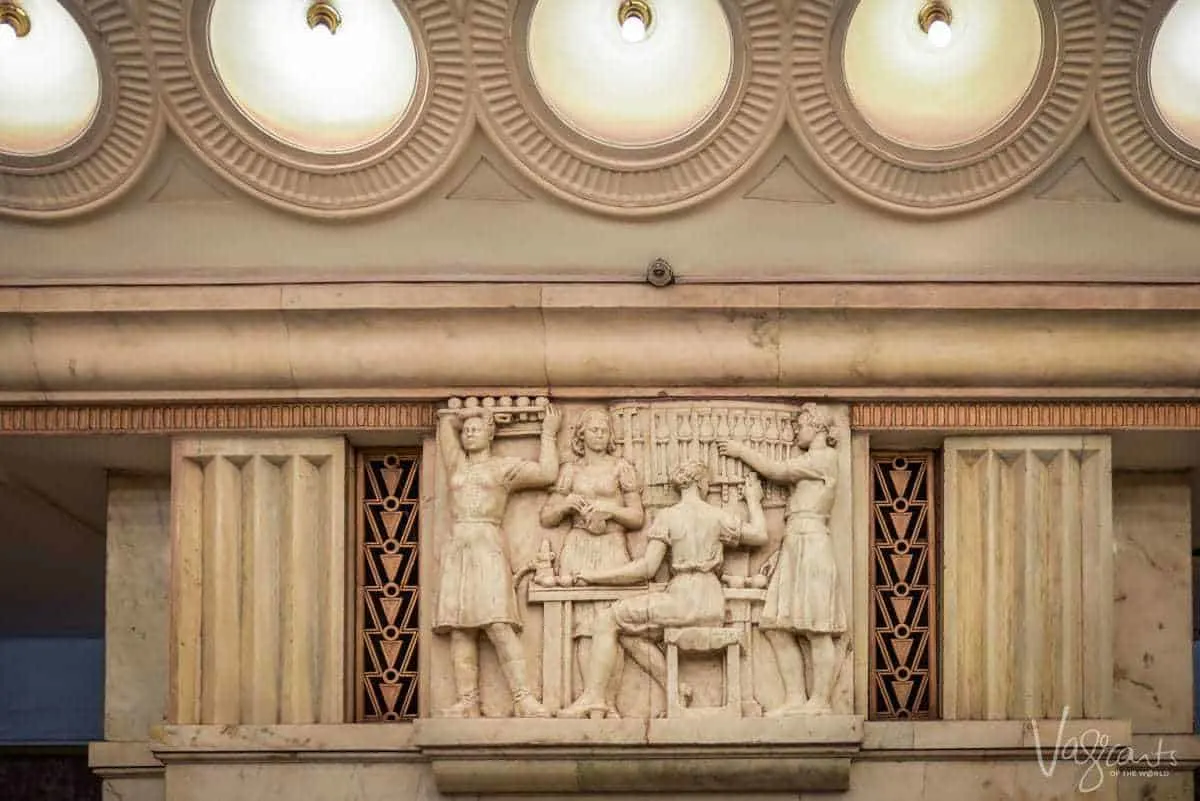
Arbatskaya Station Line 3 Blue
Arbatskaya Station is on the Arbatsko–Pokrovskaya line – Line 3. Completed in 1953, the year of Stalin’s death, Arbatskaya Station was intended as a bomb shelter. At 41 metres below ground, this station represents Stalin’s love of baroque. Arched ceilings decorated with ceramic bouquets, ornate bronze chandeliers, and glazed tiles.
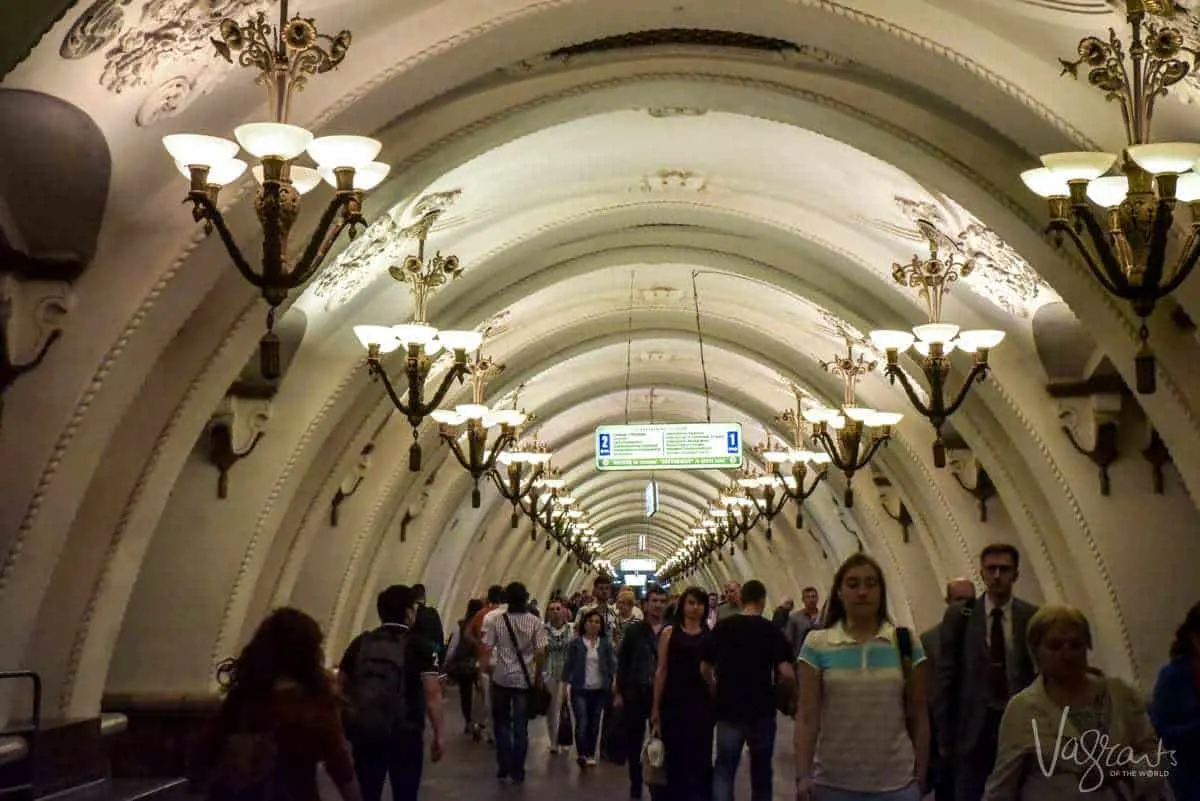
Hardly the standard decor of a bomb shelter. This station was built not long before criticism of luxury Soviet architecture resulted in austerity and functionality began to prevail.
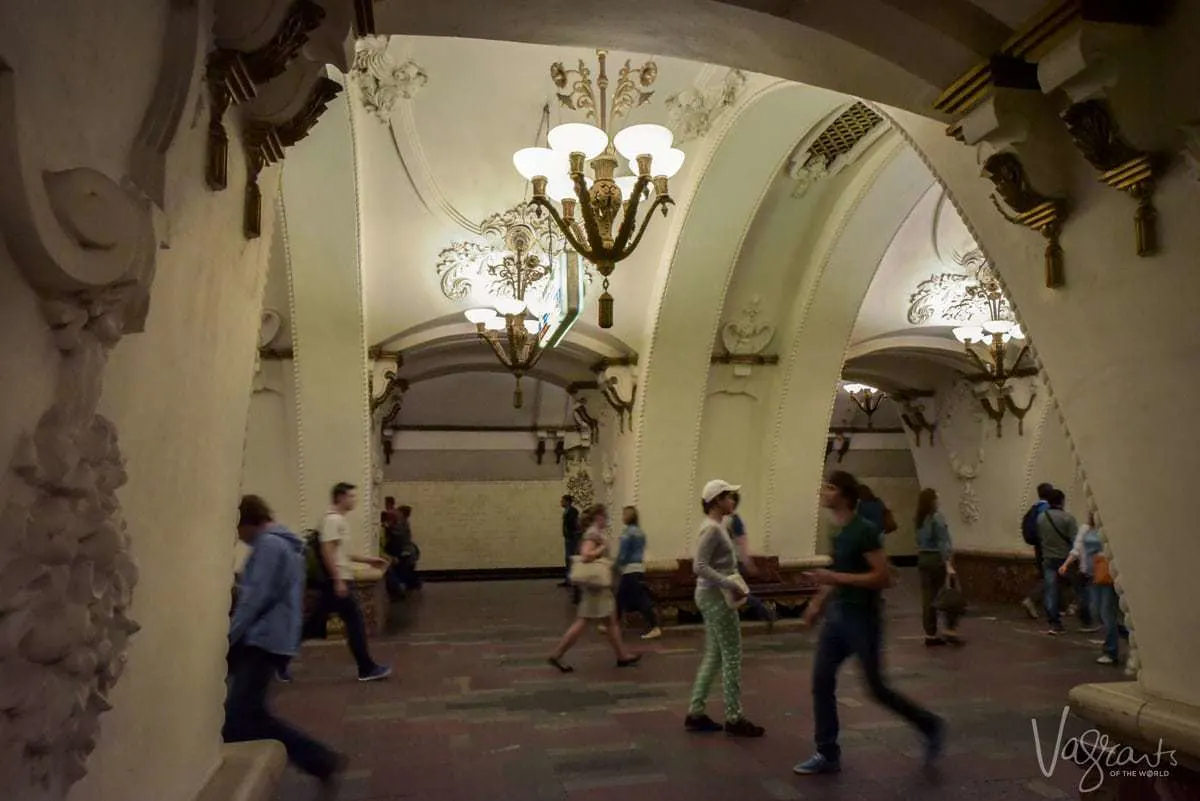
Park Pobedy Line 3 Blue
Park Pobedy Station is on two lines: the Arbatsko–Pokrovskaya line and the Kalininsko–Solntsevskaya line.
Park Pobedy (Victory Park) features a modern design in hues of red marble with mosaics depicting great Russian victories including the 1812 French Invasion on the inbound platform and World War II on the outbound platform. However, beyond interior design, there are a number of interesting facts and features of Park Pobedy station.
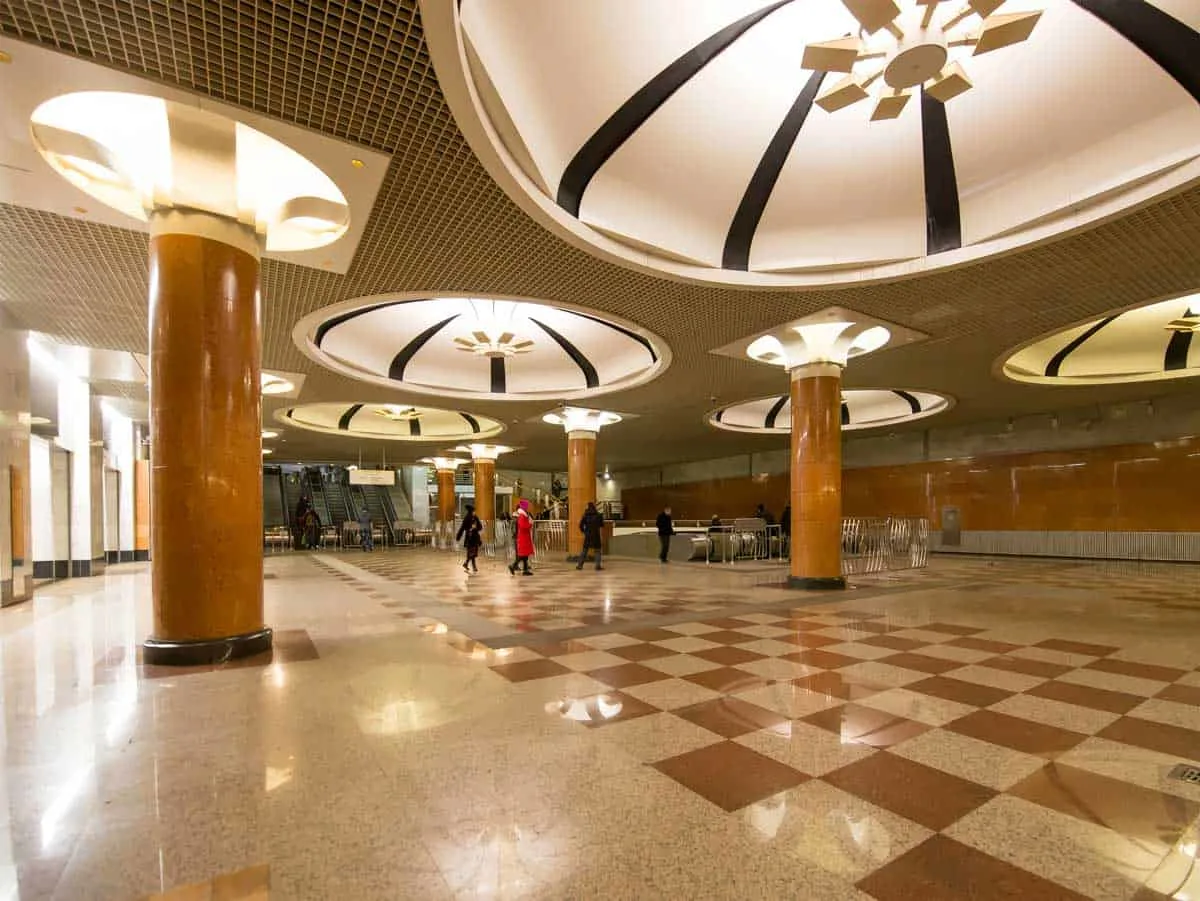
At 84 metres (276 ft), Park Pobedy is the deepest station in Moscow and the fourth-deepest in the world by mean depth, and the deepest station by maximum depth, 97 metres (318 ft).
Park Pobedy has the longest escalators in Europe. At 126 metres (413 ft) long and with 740 steps each it takes approximately three minutes to reach the surface.
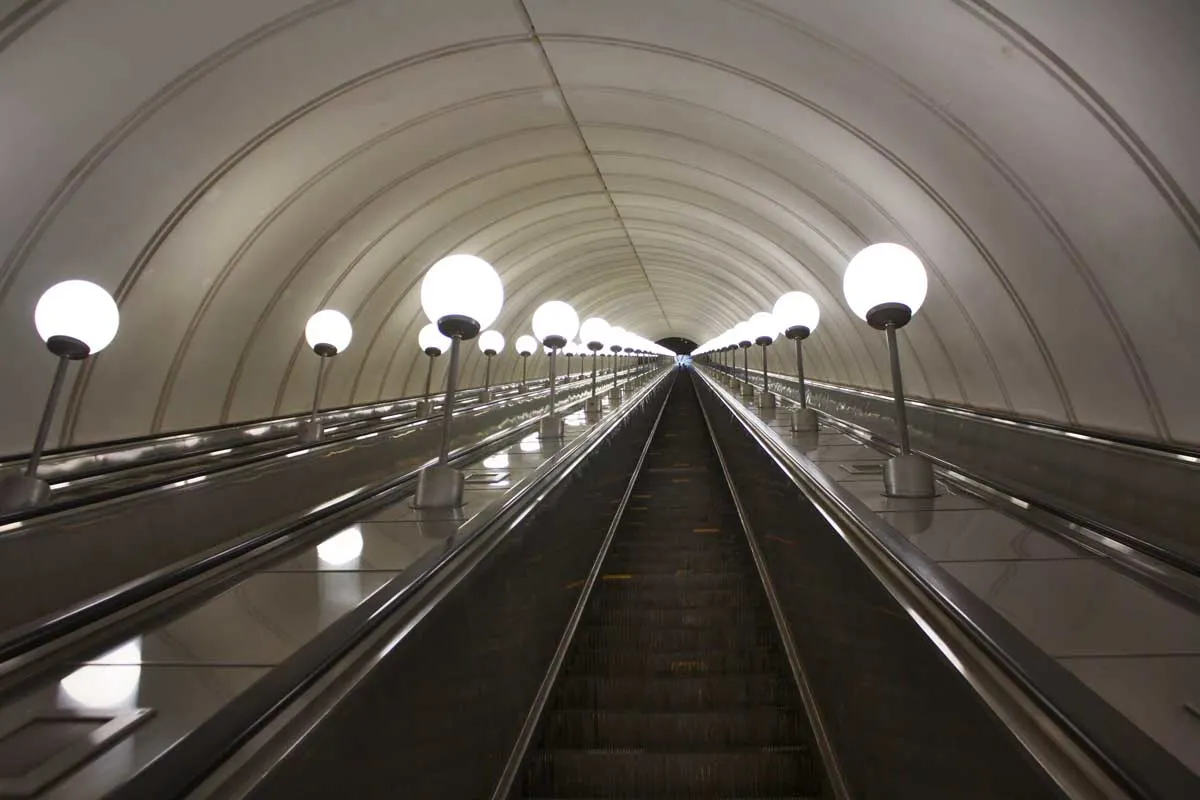
It is the only Moscow metro station where passengers board and alight trains in different locations.
The two platforms are identical in design but with opposite colour schemes. The outbound platform has pylons faced with red marble on the transverse faces and pale grey marble on the longitudinal faces. The inbound platform is the exact reverse.
The unique structural design. The Park Pobedy tunnel lining included steel blocks filled with concrete instead of traditional cast-iron tunnel lining. Reducing the amount of structural metal consequentially reduced the overall cost of construction.
Slavyansky Bulvar Station Line 3 Blue
Slavyansky Bulvar station is on the Arbatsko-Pokrovskaya Line, between Kuntsevskaya and Park Pobedy stations – Line 3. Opened in 2008, Slavyansky Bulvar is one of the more modern metro stations.
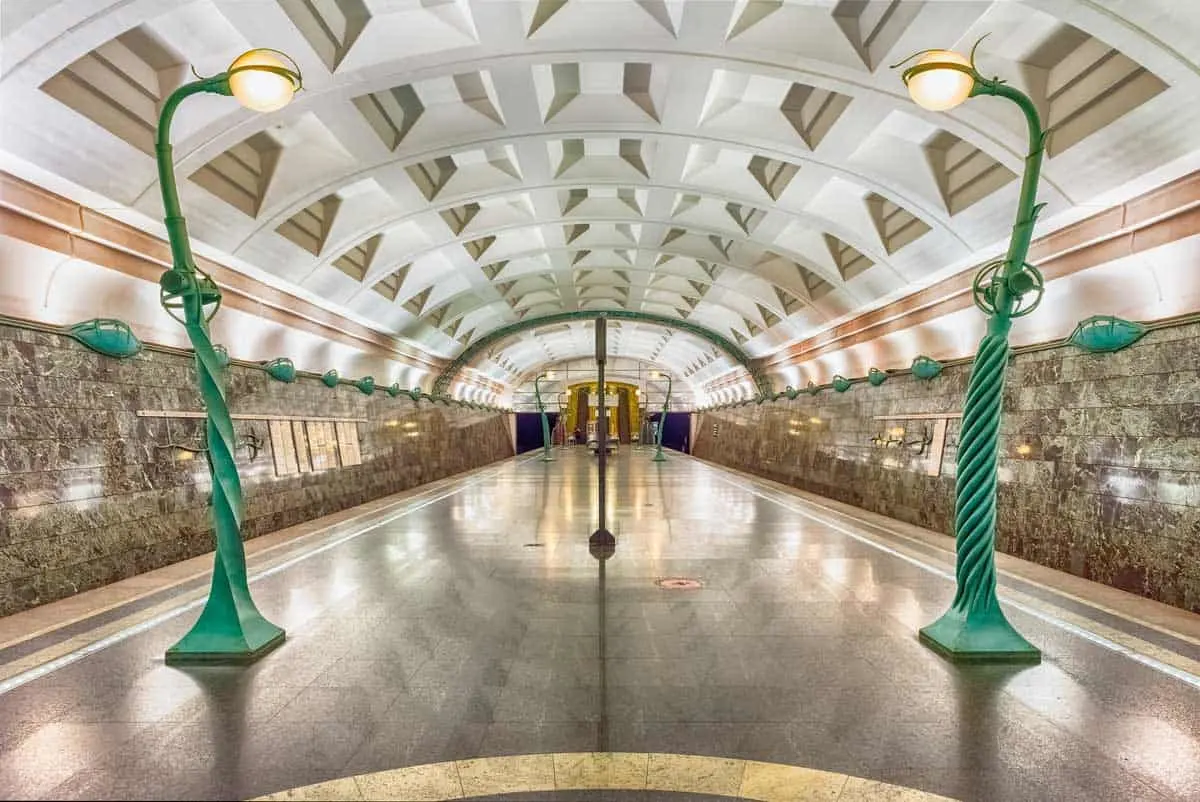
The shallow underground station hall sits at around 10 meters, lined with sleek finishes of green Cuban marble “Verde Guatemala”, granite, aluminium and beech.
However, the green Art Nouveau flourishes chosen by Architect S.Volovich, similar to those that adorn the entrances to the Paris Metro system, give Slavyansky Bulvar station an almost whimsical beauty.
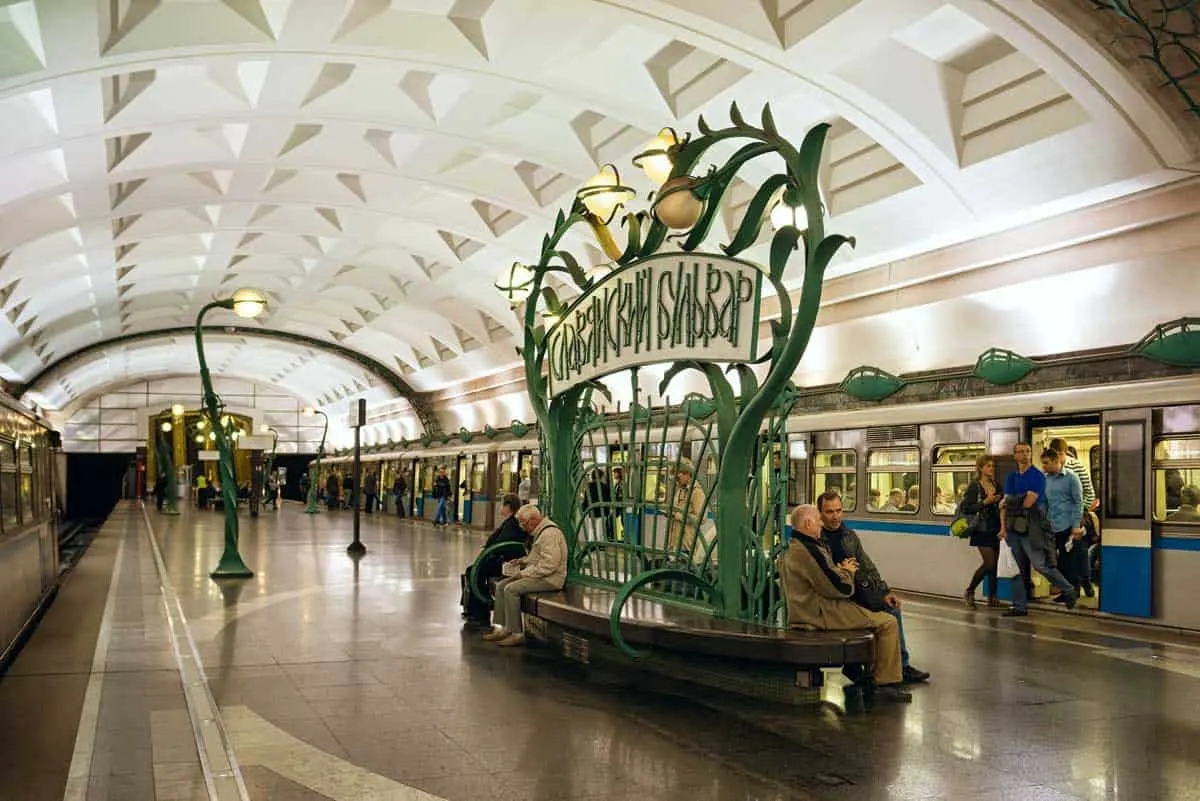
Taganskaya Station Line 5 Brown (Circle Line)
Taganskaya Station is on the Koltsevaya line – Line 5 Circle Line. Opened in 1950 Taganskaya Station is named after the Taganka Square, a major junction of the Sadovoye Koltso ring road.
Despite the fairly practical naming inspiration, the pylon station is anything but boring.
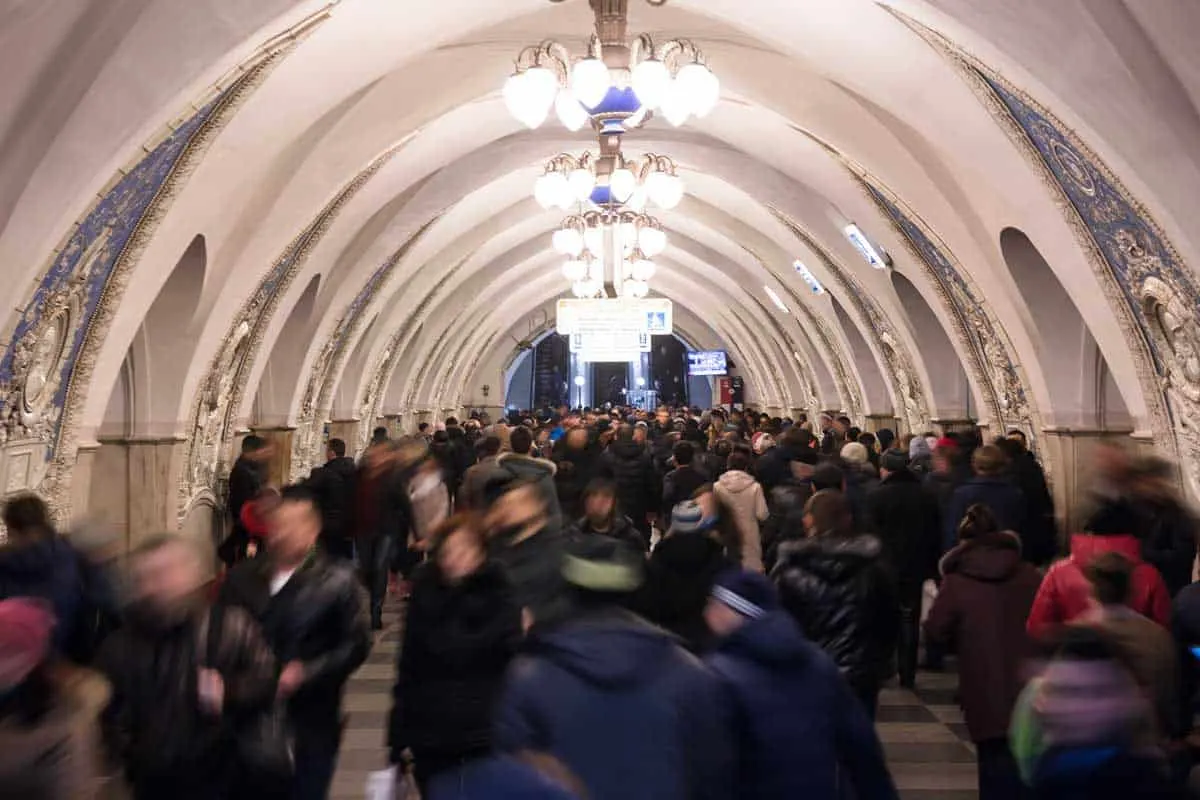
Post-war flamboyance is at the forefront of the design based on traditional Russian motives.
The central feature of the station – 48 maiolica panels on each face each pylon with floral elements and bas-reliefs of various World War II Red Army and Navy servicemen.
The colour of the panels are balanced in such a way, those facing the central hall are on a soft blue background, while platform panels are monochromatic. Lit by 12 gilded chandeliers, Taganskaya is a very elegant station.
Between 1950 until 1958 it was the deepest station in the Moscow Metro.
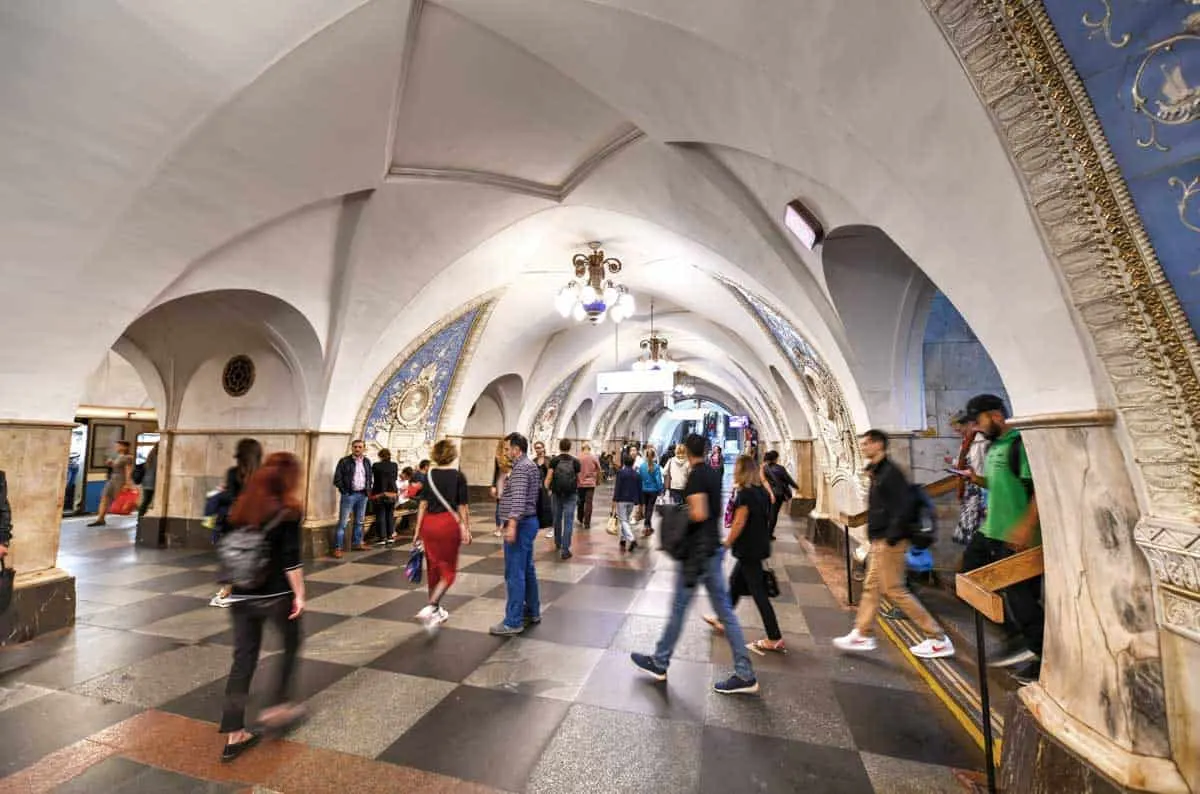
Komsomolskaya Station Line 5 Brown (Circle Line)
Komsomolskaya Station is on the Koltsevaya line – Line 5. By far the fanciest of all the stations, Komsomolskaya is more like a grand ballroom than a train station. Opened in 1952 as part of the second stage Metro expansion, this baroque masterpiece honours the memory of Nevsky, Donskoy and other great military leaders in the ornately gilded mosaics on the ceilings and walls.
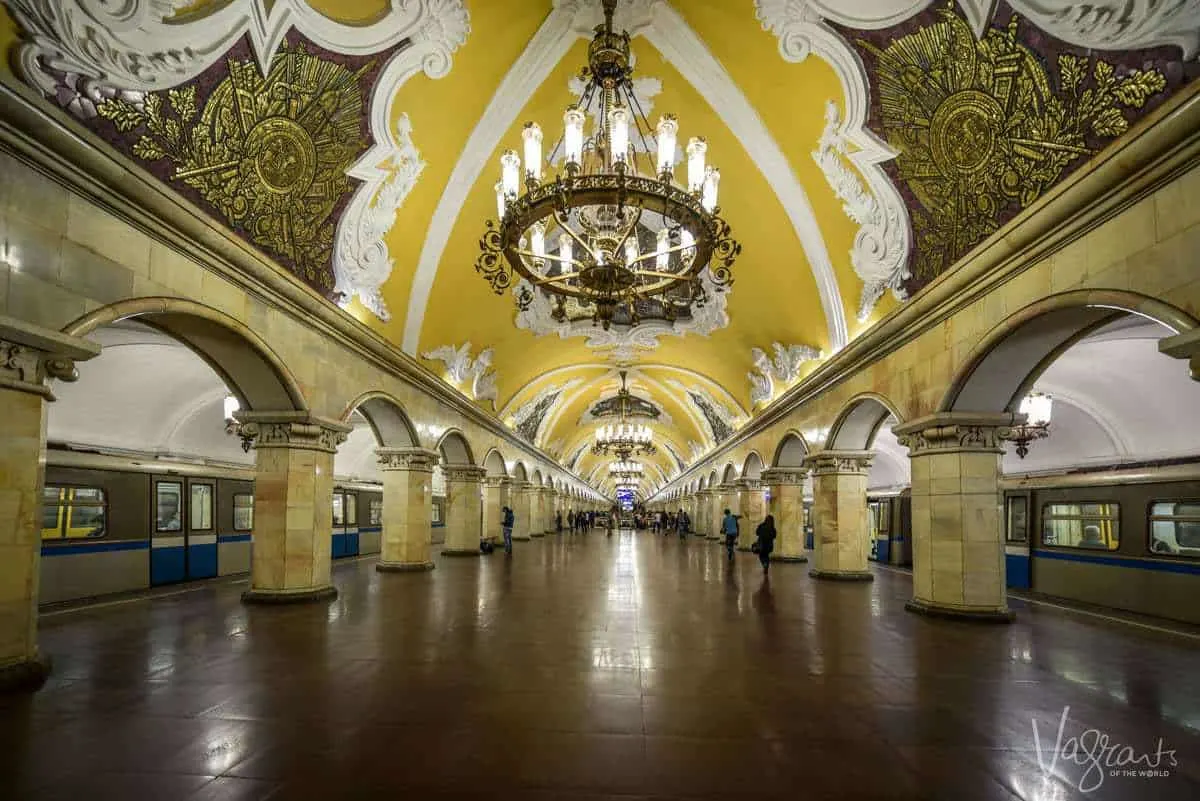
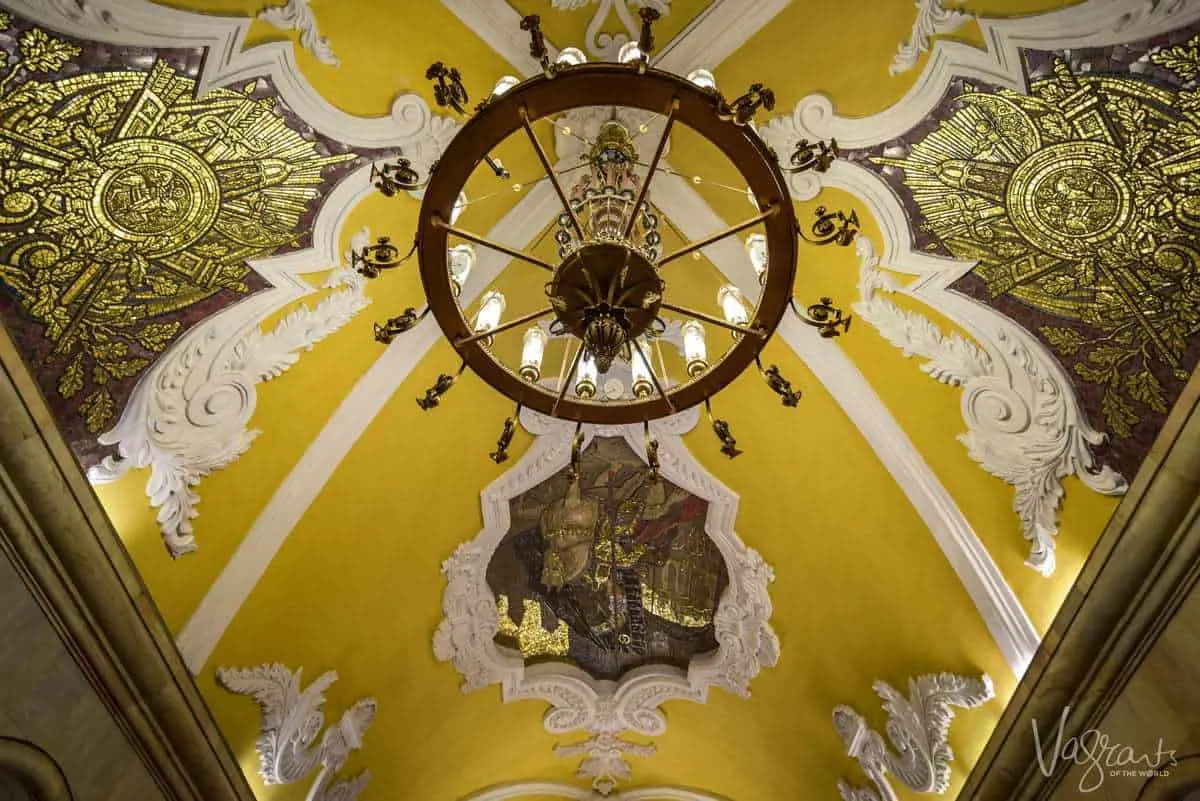
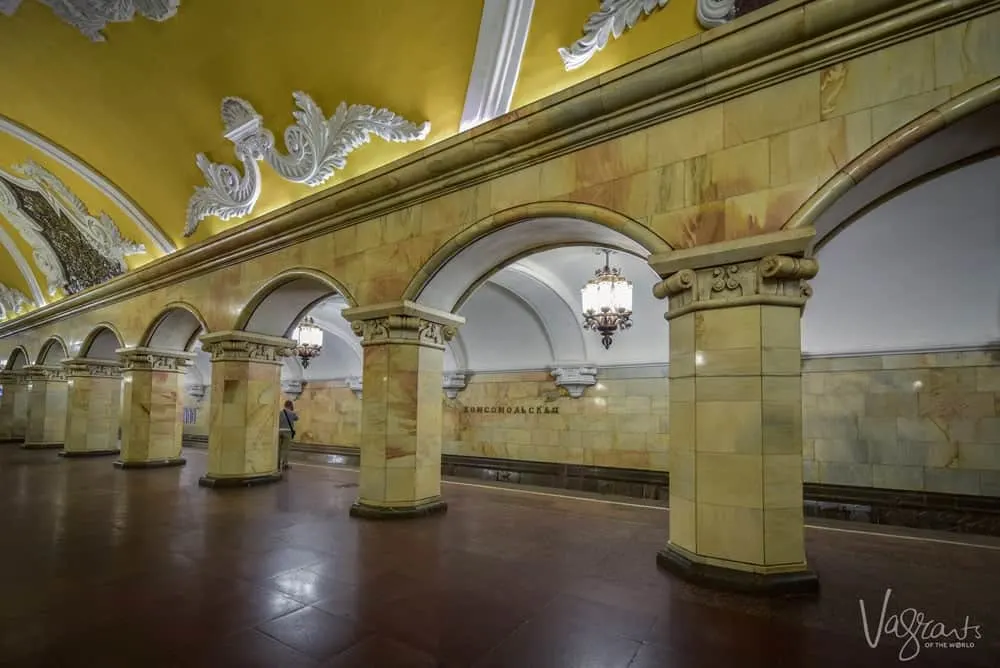
Prospect Mira Line 5 Brown (Circle Line)
Prospekt Mira station is on the Koltsevaya line – Line 5. Located on the central Circle Line, it’s easy to see why the incredibly ornate station is a favourite with visitors to Moscow.
Designed by architects Vladimir Gelfreykh and Mikhail Minkus, the station was initially named Botanichesky Sad after the Botanical Garden of Moscow and State University located nearby.
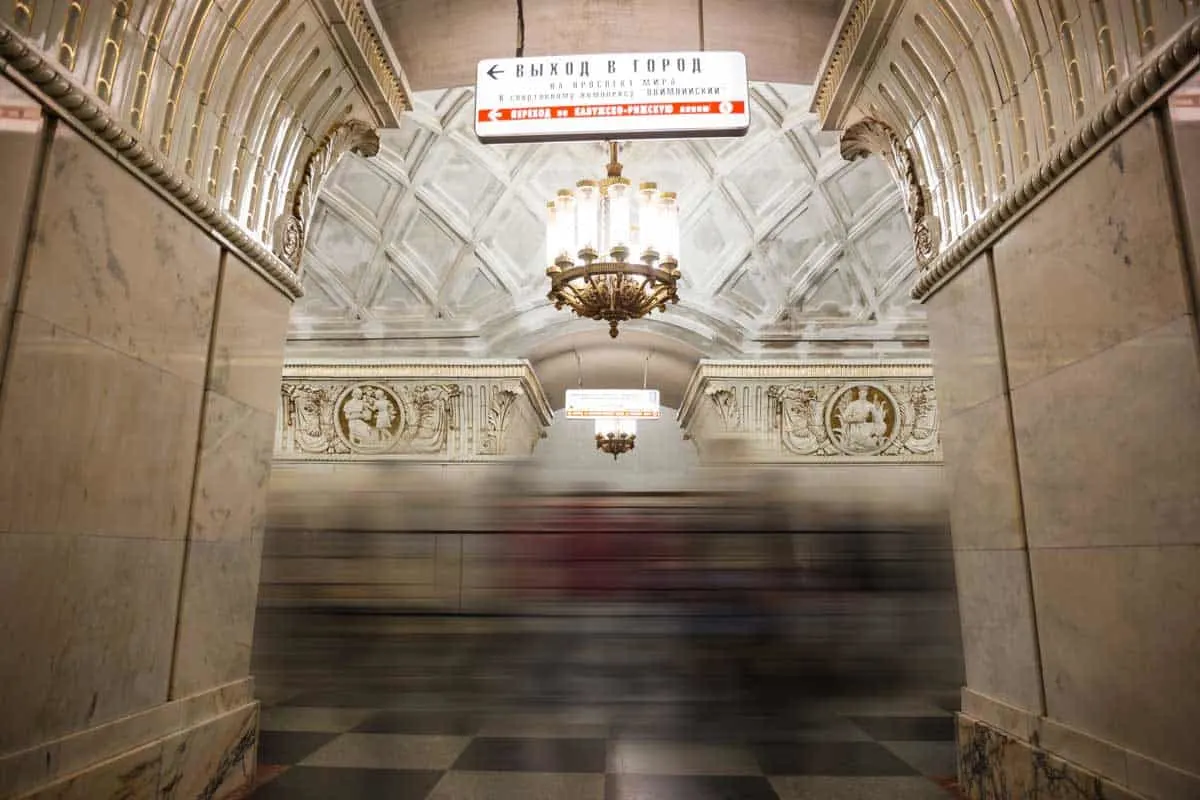
Opened in 1952, the station underwent significant modifications in 1958, removing a wall at the end of the station to make way for a transfer station on the Rizhskaya line. In 1966, both stations were renamed Prospekt Mira to avoid confusion.
The station’s design reflects the botanical influence of the original name in the intricate floral ceramic bas-reliefs trimmed in gold above flared marble arches. In the centre, medallion bas-reliefs depict aspects of agriculture in the Soviet Union. But the cylindrical crystal chandeliers add the finishing touch to the station’s grandeur, creating a magnificent ballroom atmosphere. The station was closed between 2015 and 2016 for complete restoration and remodelling works.
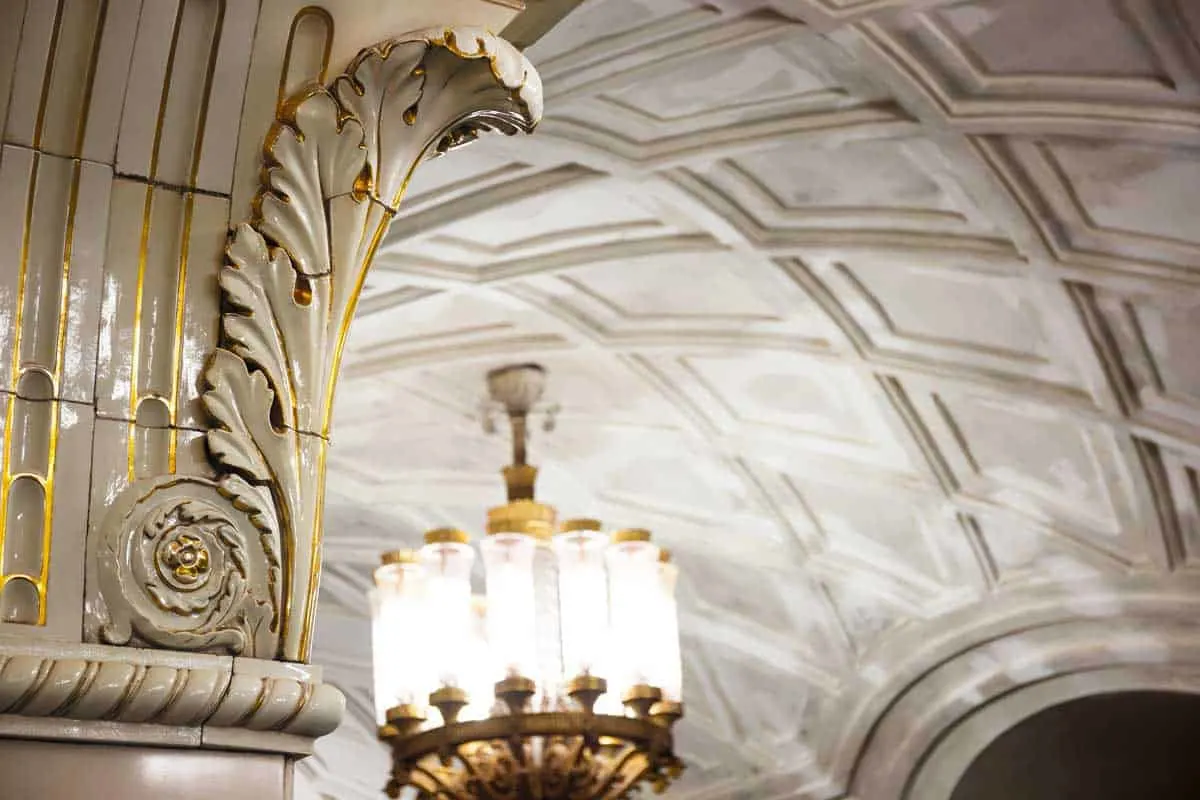
Novoslobodskaya Station Line 5 Brown (Circle Line)
Novoslobodskaya Station is on the Koltsevaya line – Line 5. Stain glass panels form the central theme for this station opened in 1952. Architect Alexey Dushkin had long wanted to utilise stain glass as the central feature of a metro station.

Dushkin persuaded a renowned artist, Pavel Korin to compose the artworks for the panels and the rest of the station was designed around the 32 stained glass panels, each surrounded by elaborate brass borders. The concept was to create the impression of an underground crypt.
Kievskaya Station Line 5 Brown (Circle Line)
Kievskaya Station is on the Koltsevaya Line, Line 5 Circle line. An open competition held in Ukraine for the design of Kievskaya Station attracted 73 entries.
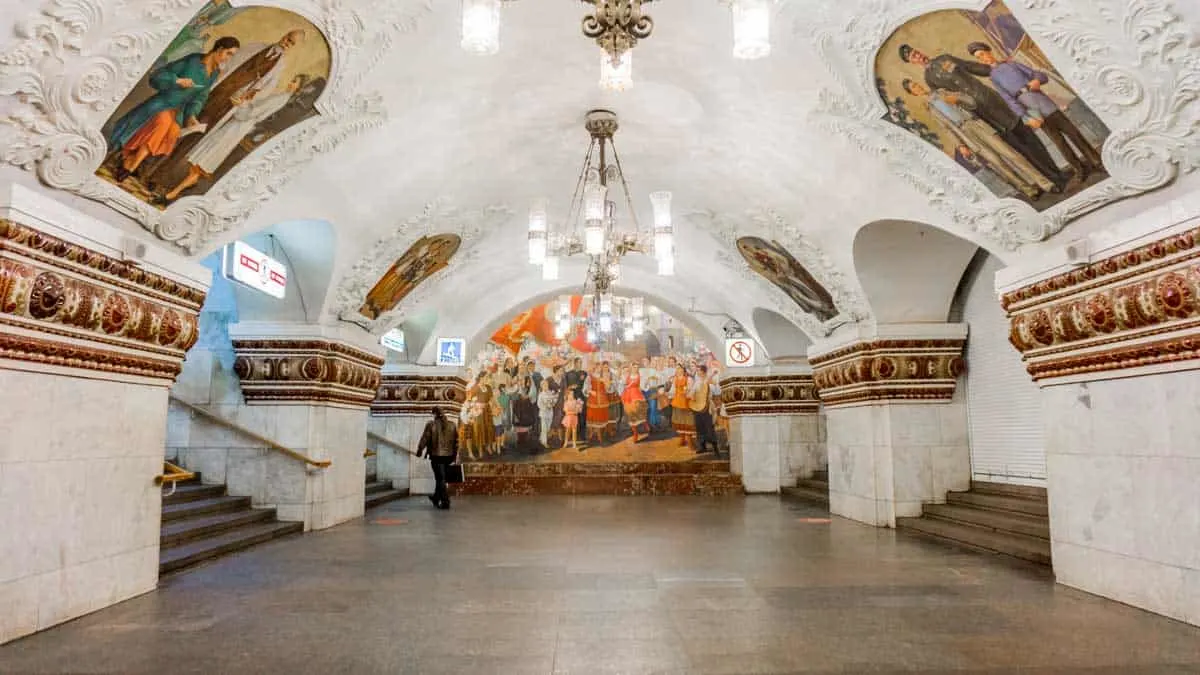
The winning team of E. I. Katonin, V. K. Skugarev, and G. E. Golubev focused the station’s theme on the Russo-Ukrainian unity from the time of Pereyaslav Rada in 1654 to the October Revolution in 1917, evident in the large, bright mosaics throughout the station and the portrait of Lenin in the main hall. The station is a true monument to the Soviet era and Soviet Russia.
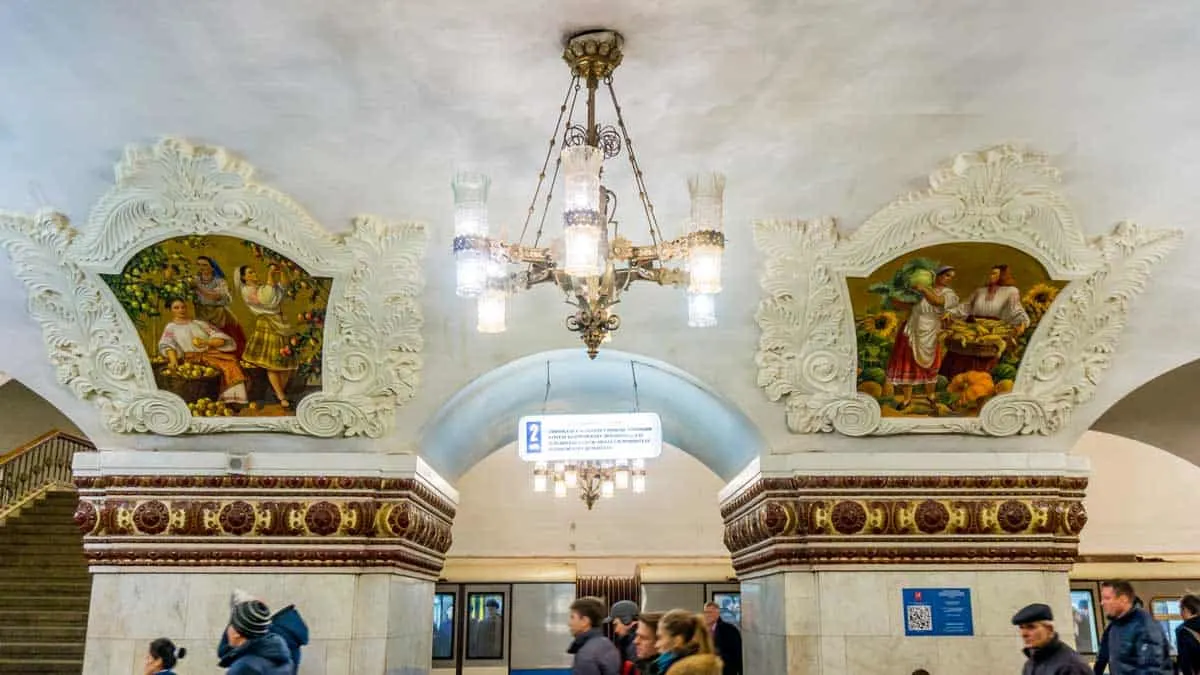
Stark white granite and marble arches accented with gold flourishes lit by central chandeliers against the bold mosaics is almost overwhelmingly elaborate.
One of the station’s entrances features a reproduction classic Art Nouveau Paris Metro entrance by Hector Guimard. The entrance was given to the Moscow Metro by the Régie Autonome des Transports Parisiens in exchange for a piece by Russian artist Ivan Lubennikov installed at Madeleine station in Paris.
Aviamotornaya Station Line 8 Yellow
Aviamotornaya Station is on the Kalininsko–Solntsevskaya line – Line 8. A tribute to Russian aviation, Aviamotornaya Station’s design is entirely in the spirit of flying.
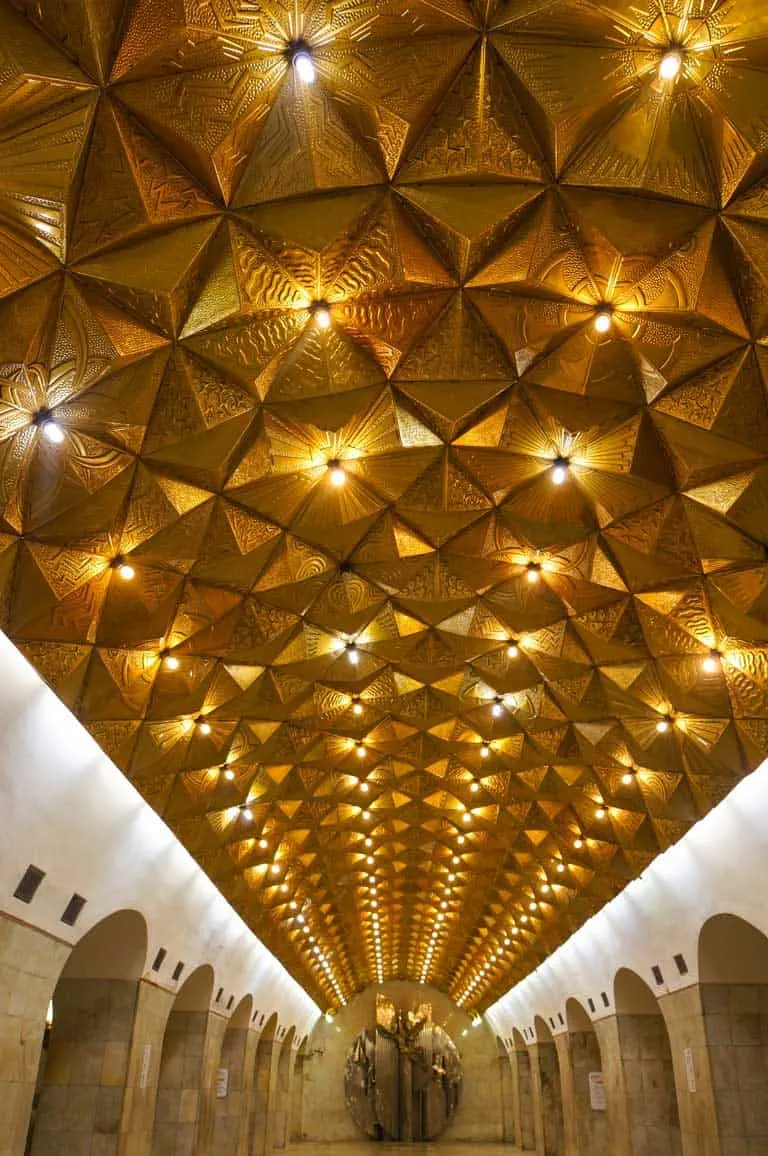
The most striking feature of the station is the ceiling in the central hall covered with four-sided anodised gold pyramids depicting the universe. At the end of the impressive foyer, an imposing metal sculpture depicting the flight of Icarus. An ode to the lives of aviators and inventors lost in the pursuit of flight.
The lighting on the platforms gives commuters the sense of movement and flying with the impression of an aeroplane jet streams and triangular lighting to represent an aeroplane tail wing.
Located 53 metres (173 feet) underground, the beautiful station was the location of a terrible escalator accident in 1982, causing the death of 8 people and injuring 30. You can read more about the incident here.
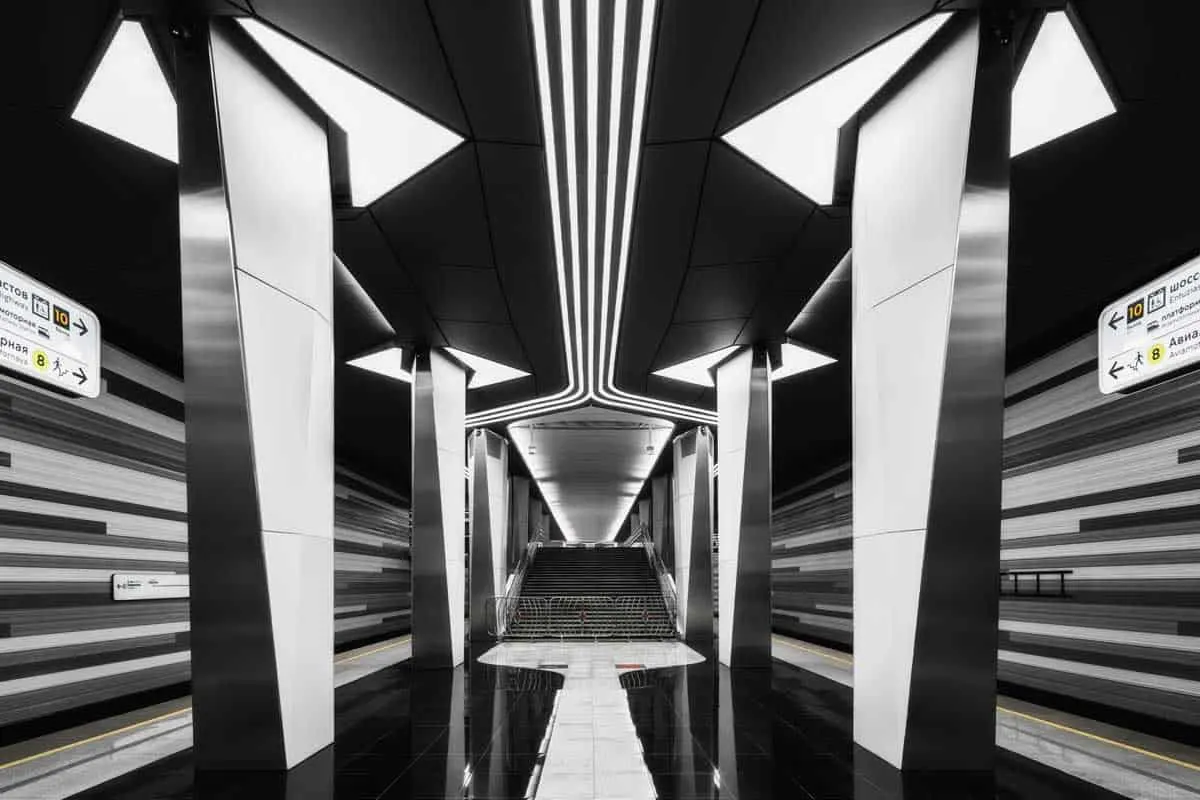
Dostoyevskaya Station (Dostoevsky) Line 10 Light Green
Dostoyevskaya Station is on the Lyublinsko-Dmitrovskaya line – Line 10. A Moscow Metro station for die-hard literary fans.
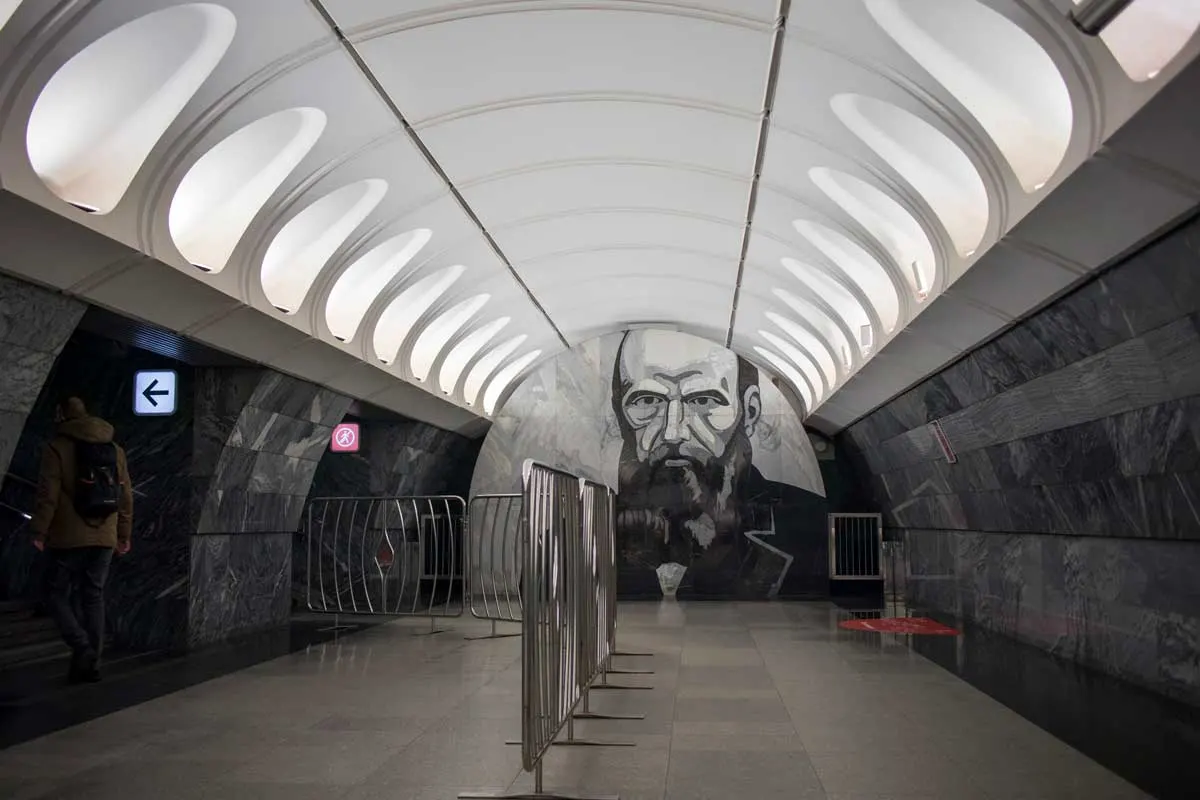
A bid to honour one of Russia’s most celebrated writers and greatest thinks has been shrouded in controversy from the get-go. Opened in 2010, named after the famous author Fyodor Dostoyevsky, the station is beautifully stark with bare grey walls except for colourless murals depicting scenes from Dostoevsky’s most famous novels, including Brothers Karamazov, The Idiot, and, Crime and Punishment.
The controversy started when elements of the station’s design were published online. Two scenes of violence, including scenes of homicide and suicide depicted on the station walls, sparked debates within the internet community. Psychologists expressed concern about the dark murals saying the violent scenes from Dostoevsky’s books could put commuters in equally dark moods or even provoke suicidal impulses.
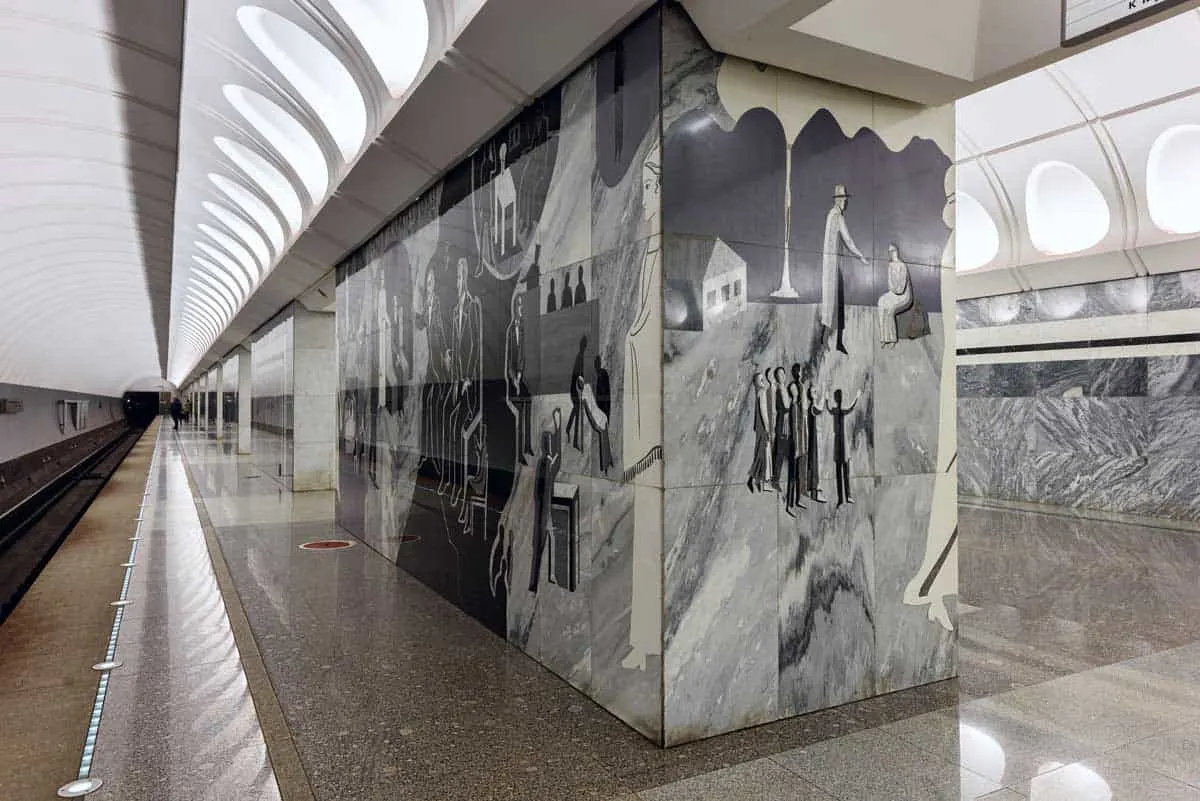
The beautifully stark station caused controversy on its opening in 2010 after people objected to a mural depicting a murder scene, to which the artist responsible replied:
Ivan Nikolayev, 69, the artist commissioned to create the murals, spent 20 years rereading Dostoevsky’s books and making sketches for the project. In response to the controversial reactions to the station’s works, the artist replied: “I was tasked to draw the meaning, creativity and entire life of Dostoevsky. “What did you want? Scenes of dancing? Dostoyevsky does not have them.”
More Moscow Metro Stations Worth Visiting
If you have time and want to see more interesting stations on the Moscow Metro, the following stations are worth your time for their unique design and architecture.
- Line 1 Red: Krasnye Vorota, Kropotkinskaya, Okhotny Ryad, Vorob’yevy Gory ( The only station located on a bridge across the Moscow River)
- Line 2 Green: Novokuznetskaya, Avtozavodskaya, Dinamo
- Line 5 Brown: Belorusskaya, Park Kultury
- Line 6 Yellow: VDNKh
- Line 7 Purple: Pushkinskaya, Kuznetskiy Mot, Spartak
- Line 9 Grey: Nagatinskaya
The Future of the Moscow Metro
So while Stalin’s initial vision of “People’s Palaces” may have waned somewhat during the peak Soviet Russia years where function was favoured over form, the concept of original and unique Metro stations never faded.
As Russia continues to expand its Metro system to become the third-largest in the world, the desire to create unique and beautiful spaces continues.
